Disclaimer: This is the tale of a slightly deranged traveler who thought visiting Rajasthan during monsoon was a brilliant idea. Spoiler alert – it was!
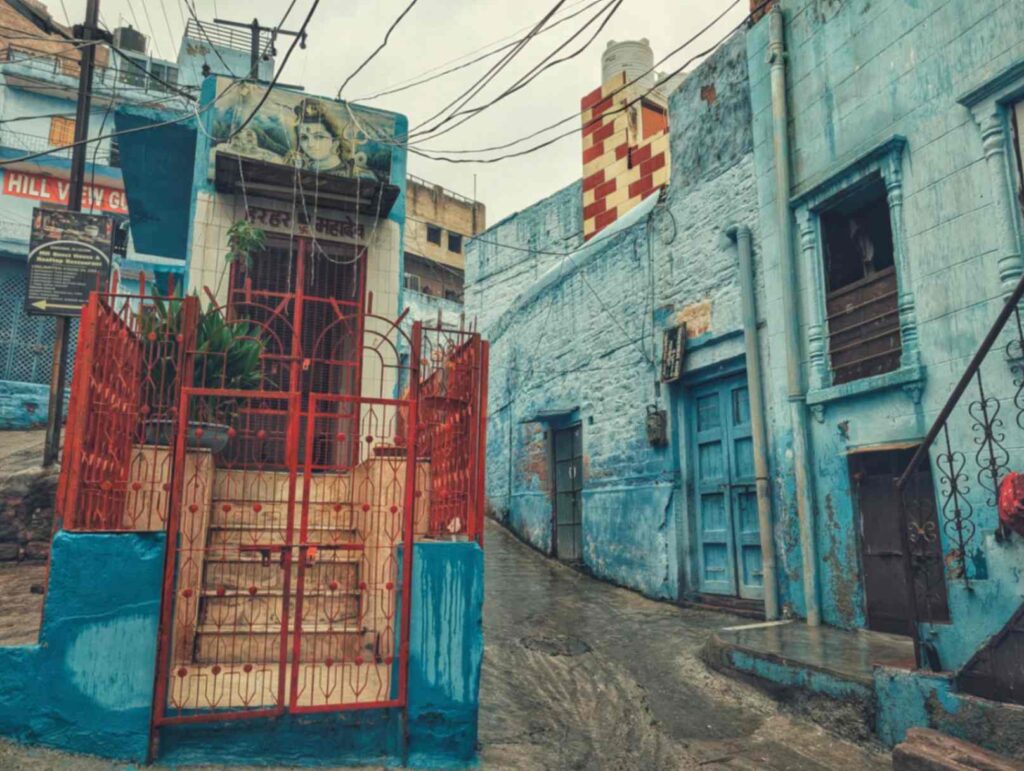
Table of Contents
My Monsoon Madness: Dancing with the Drizzle in India’s Blue City – Jodhpur
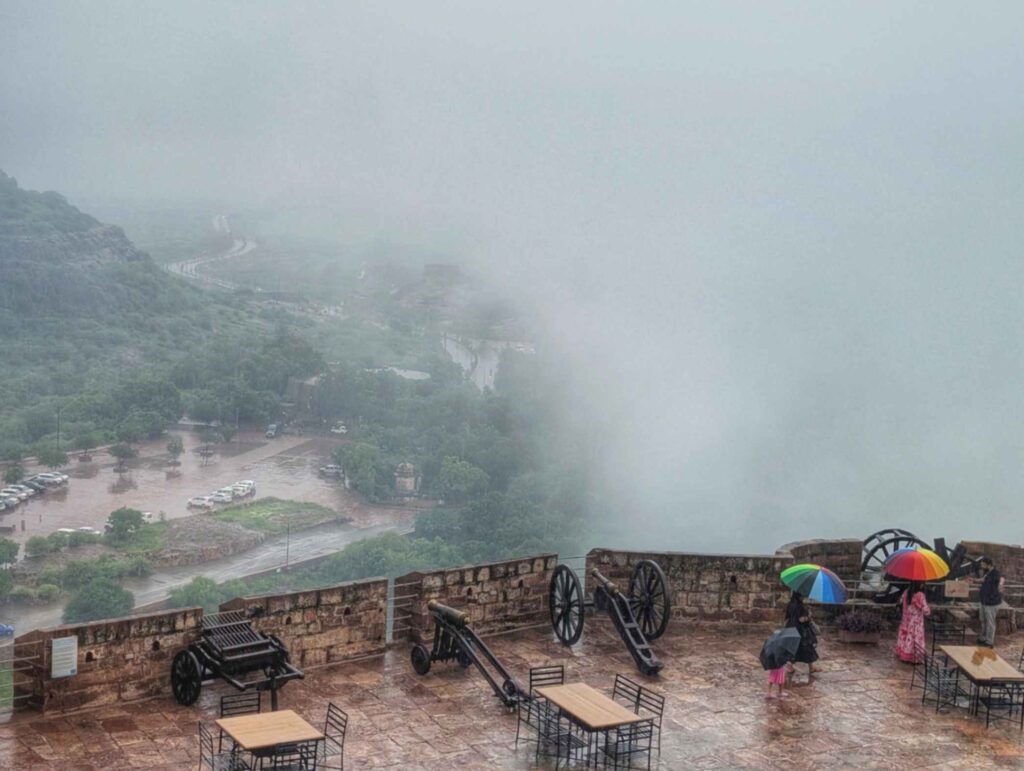
You know that moment when you realize you’ve made either the most brilliant or the most ridiculous decision of your life?
That’s exactly what hit me as I stood at Jodhpur railway station in July, watching the first monsoon drops kiss the parched earth of what’s supposed to be India’s desert state.
Yes, dear readers, in all my infinite wisdom – had decided to visit the Blue City during monsoon season.
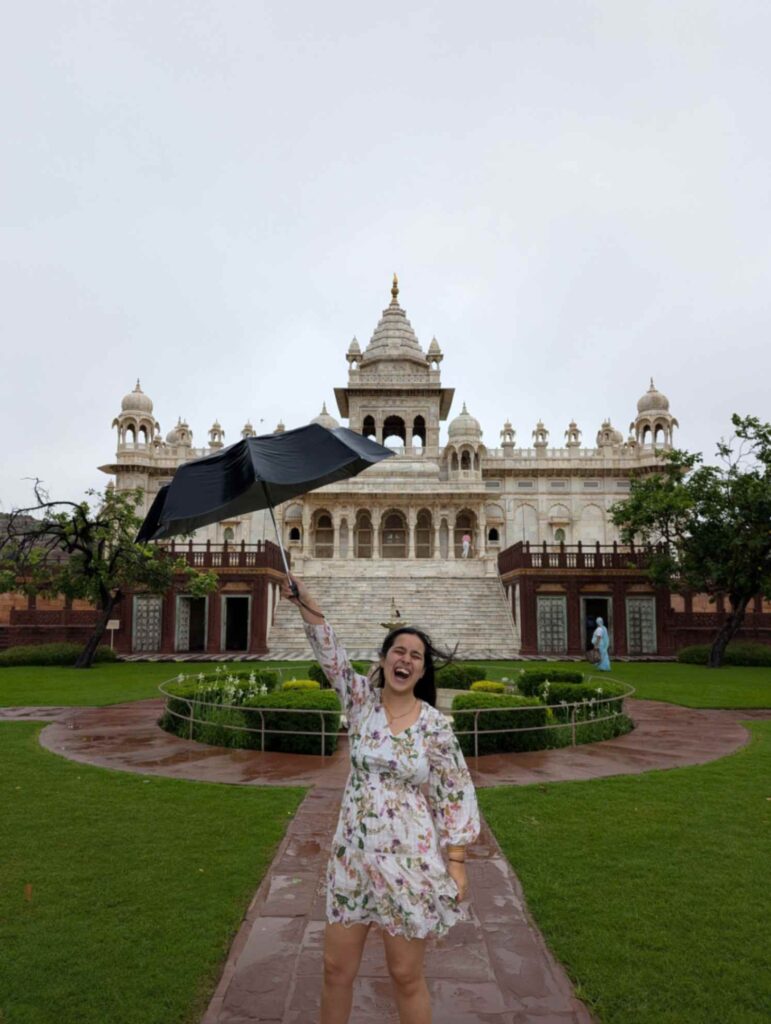
My family back home thought I’d finally lost it. “Rajasthan in monsoon?” they scoffed over video calls, shaking their heads as if I’d announced my intention to swim across the Arabian Sea. “Why not visit Pune instead?”
But here’s the thing about us travel addicts – we’re drawn to the unconventional like moths to a flickering streetlight.
And I was in for a surprise!
The moment I stepped out of that air-conditioned train compartment, I was hit by something I never expected in the land of sand dunes and scorching heat – cool, humid air that actually made me want to explore rather than hide under the nearest air conditioner.
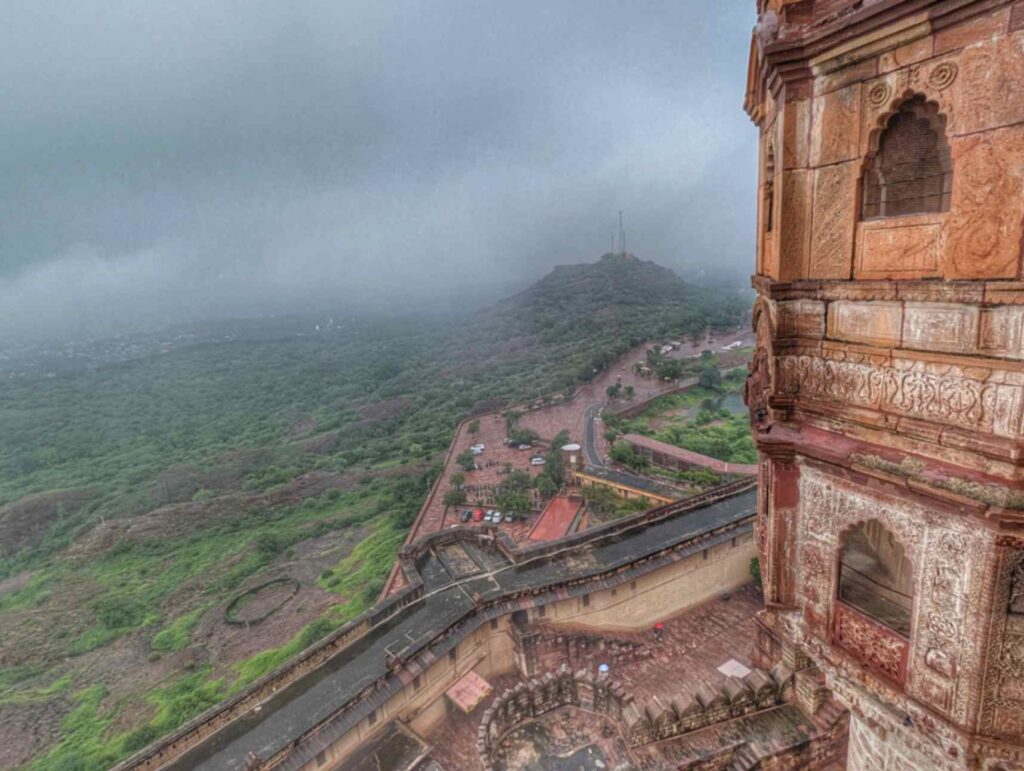
The Heritage Accommodation that Saved My Sanity
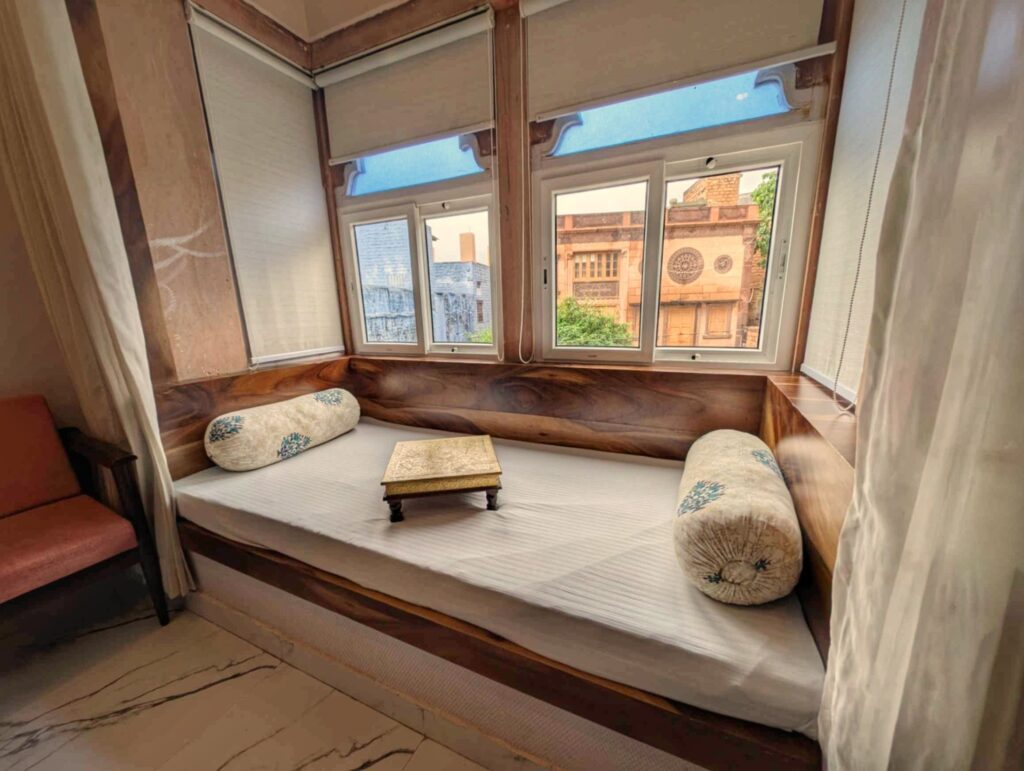
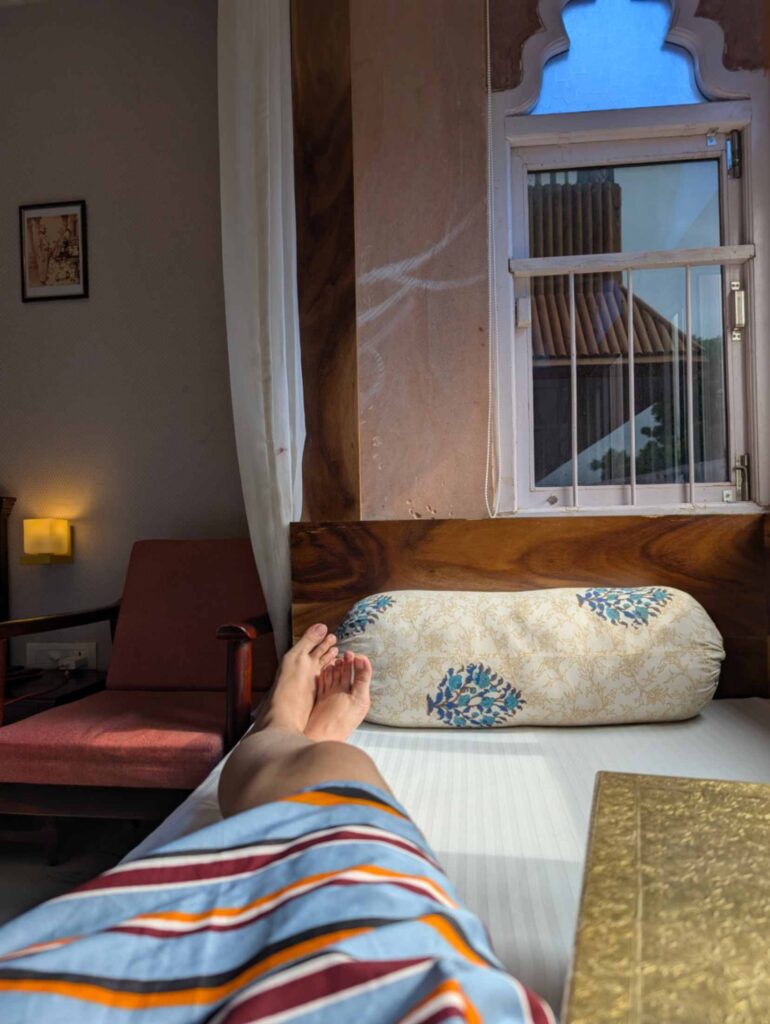
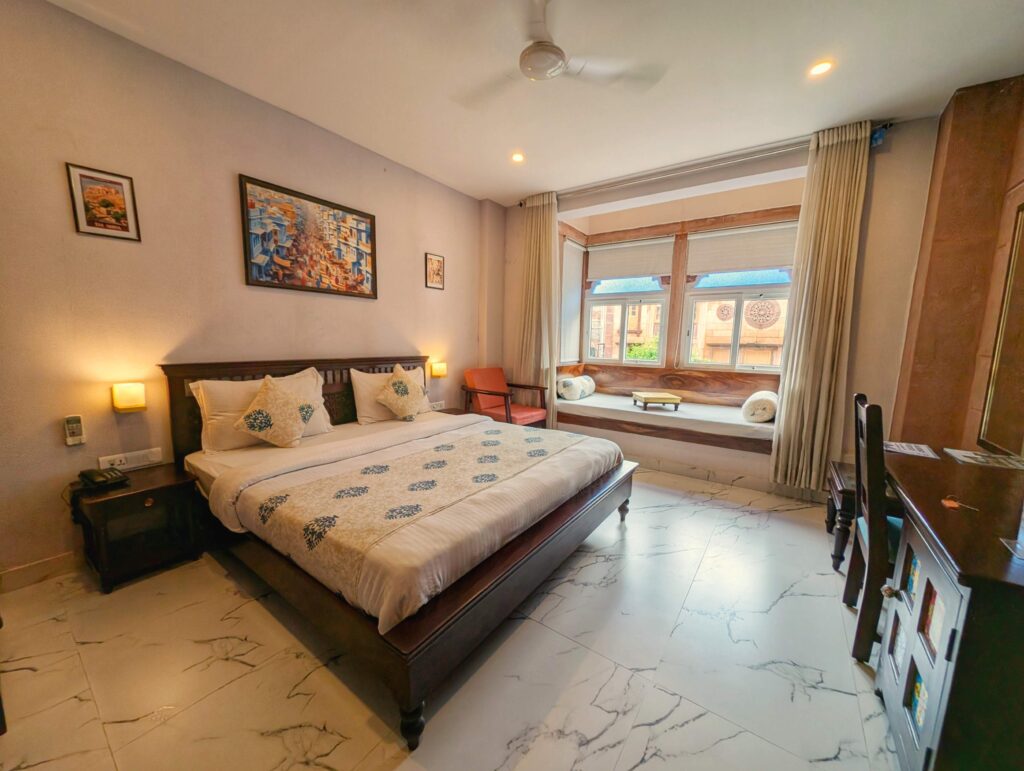
Now, let me tell you about my accommodation choice – Kankaria Heritage. Located right in the heart of the old city, this place became my sanctuary during my monsoon adventure.
What struck me immediately was how this heritage property had something most central Jodhpur accommodations desperately lack – excellent ventilation!
While most hotels and guesthouses in the city center are crammed into congested spaces with barely any windows (trust me, I peeked into a few during my wanderings), Kankaria Heritage felt like a breath of fresh air.
The rooms had proper windows that actually opened to let in the monsoon breeze, and the heritage architecture was designed keeping air circulation in mind.
The best part? The proximity to the city center. I could literally roll out of bed and be at the Clock Tower in five minutes. Well, maybe ten if I stopped for clicking pictures along the way – which, let’s be honest, was inevitable.
The Great Blue City Walking Expedition
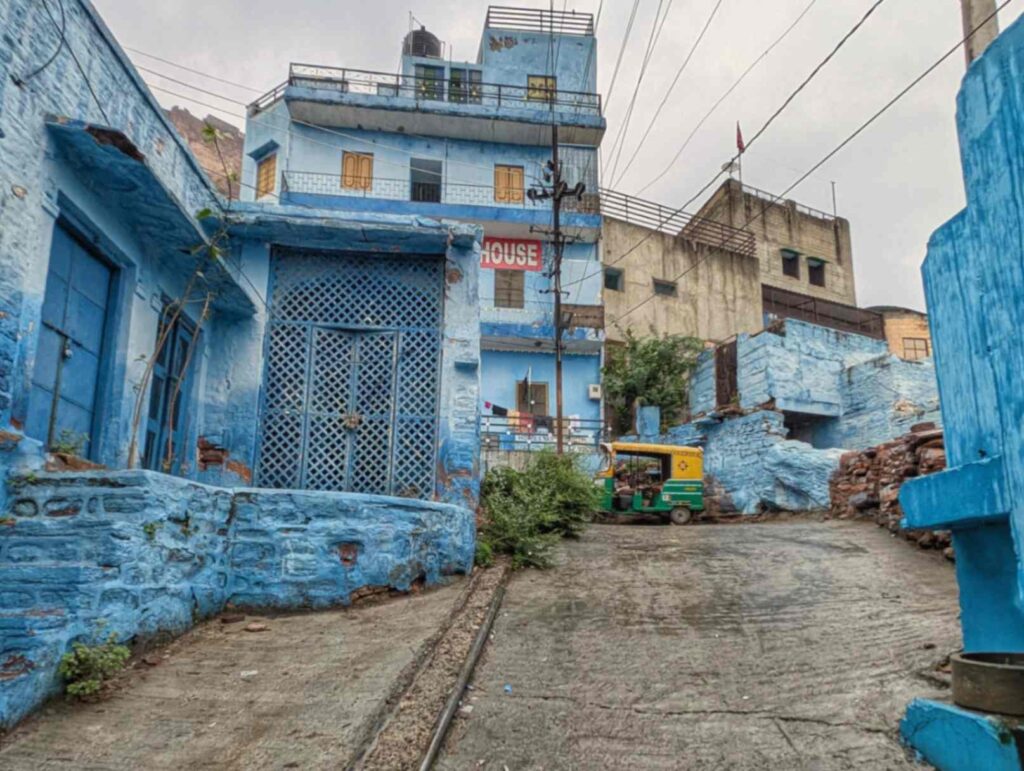
Here’s something they don’t tell you in the guidebooks – you can explore almost the entire Blue City on foot!
Armed with comfortable rain friendly floaters (and an emergency chocolate stash), I set out to discover why Jodhpur earned its cerulean nickname.
The morning after my arrival, I started my walking adventure from the Clock Tower (Ghantaghar), which locals treat like the Times Square of Jodhpur.
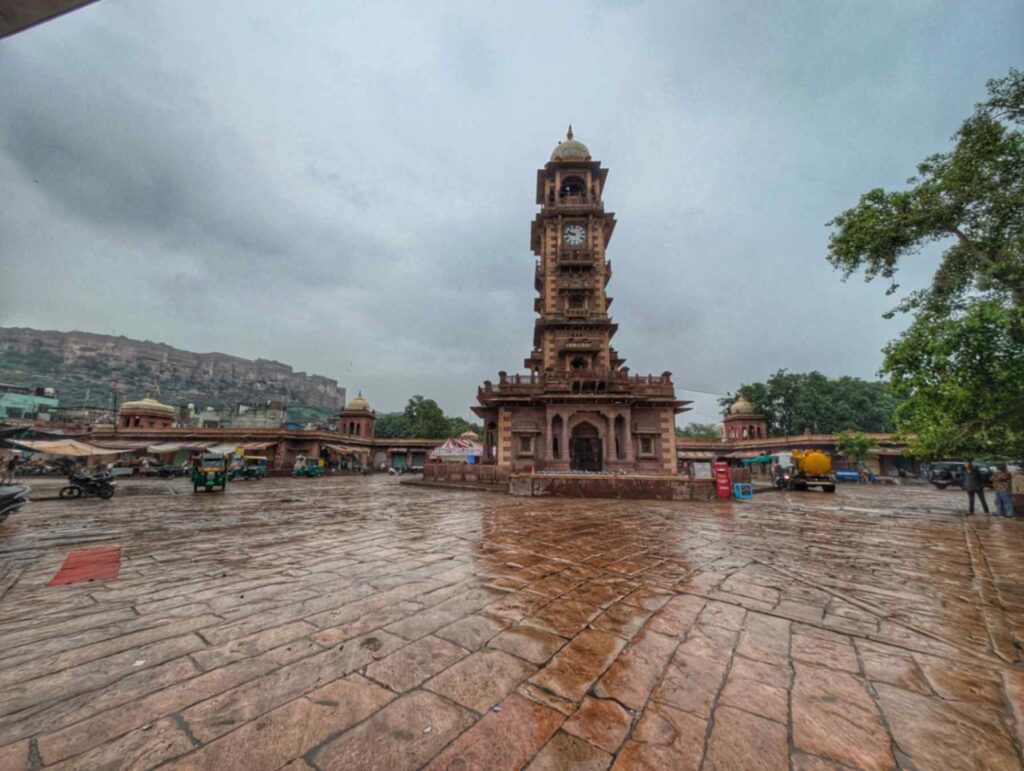
From there, the maze of blue-painted lanes beckoned like a siren’s call. The Navchokiya area turned out to be absolute goldmine for blue house hunting.
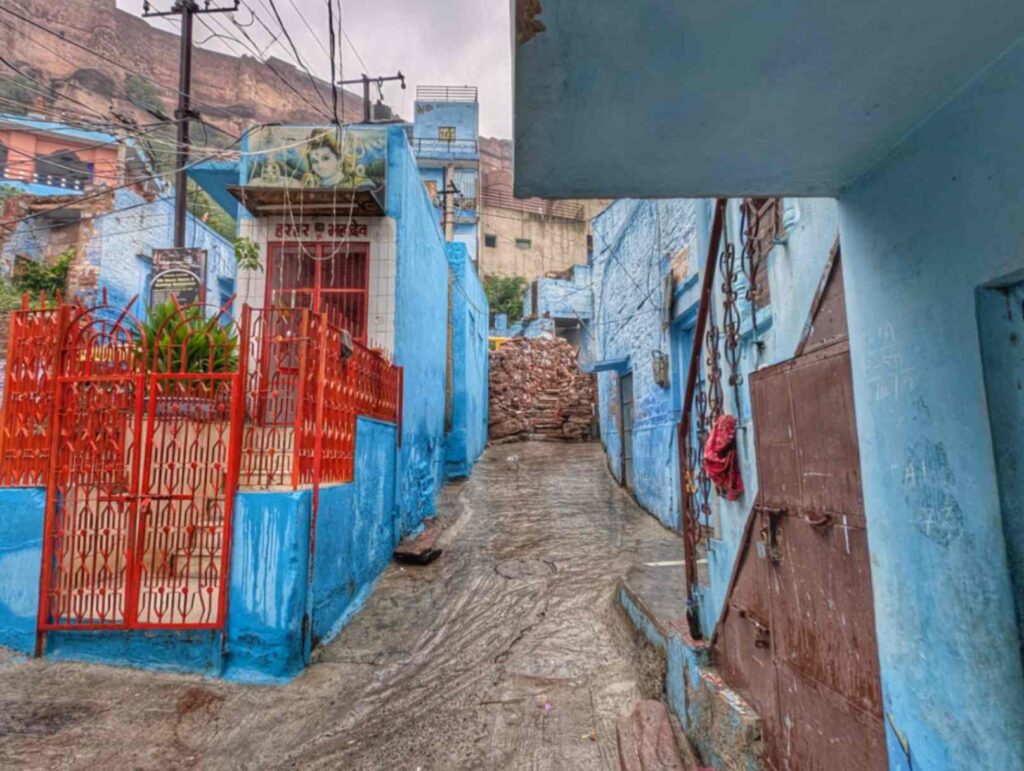
But here’s where the monsoon magic kicked in – the rain had washed all the dust off these ancient walls, making the indigo paint pop like never before.
The rains enhanced the blue hues, creating this ethereal, almost magical atmosphere that made me feel like I was walking through a living, breathing watercolor painting.
The narrow alleys twisted and turned like a medieval maze. I swear I took the same left turn at least three times and somehow ended up at different places each time.
Either the city has some serious architectural wizardry going on, or I have the navigation skills of a dizzy pigeon. Probably the latter.
The Legendary Mehrangarh Fort and Its Dark Secrets
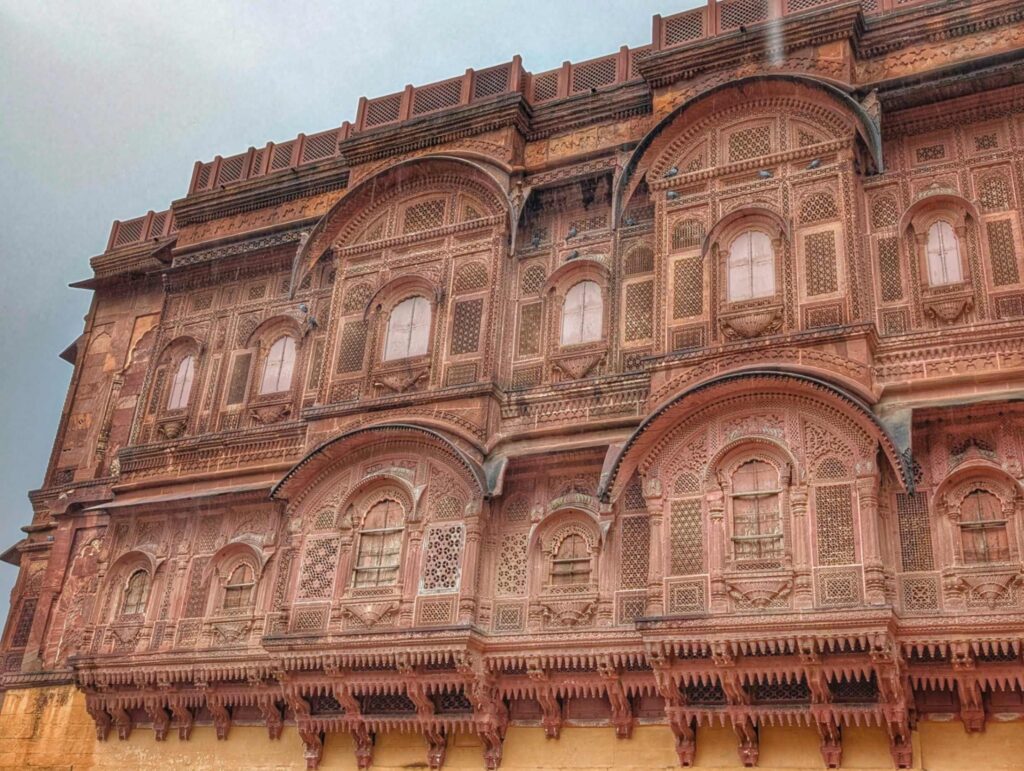
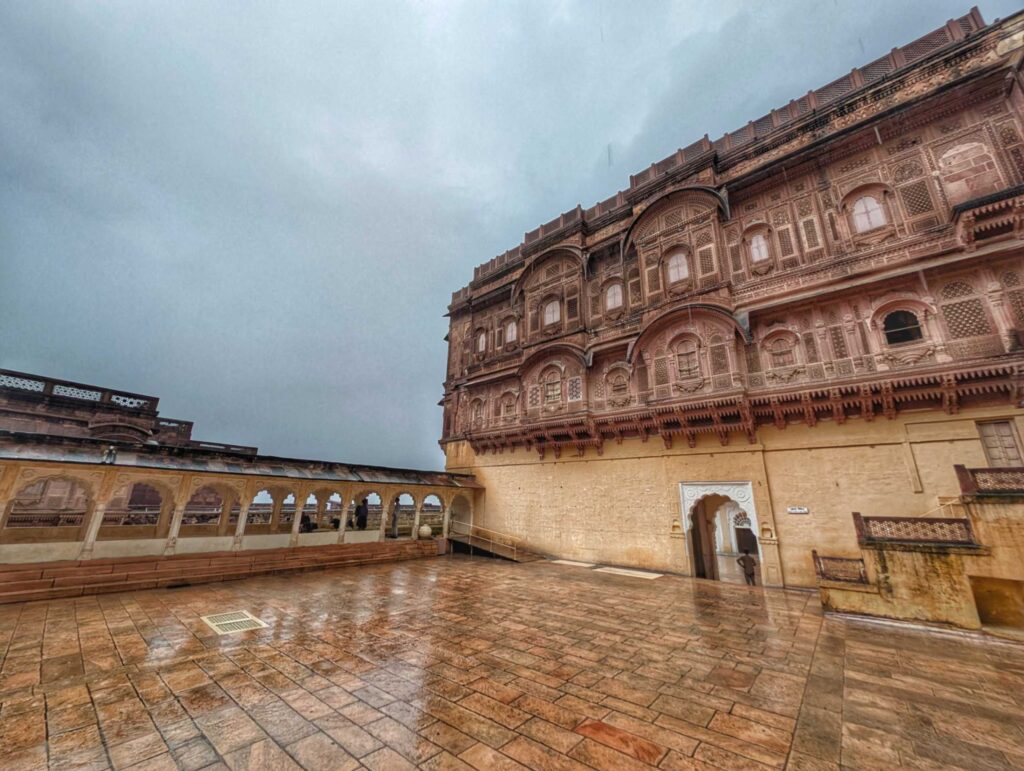
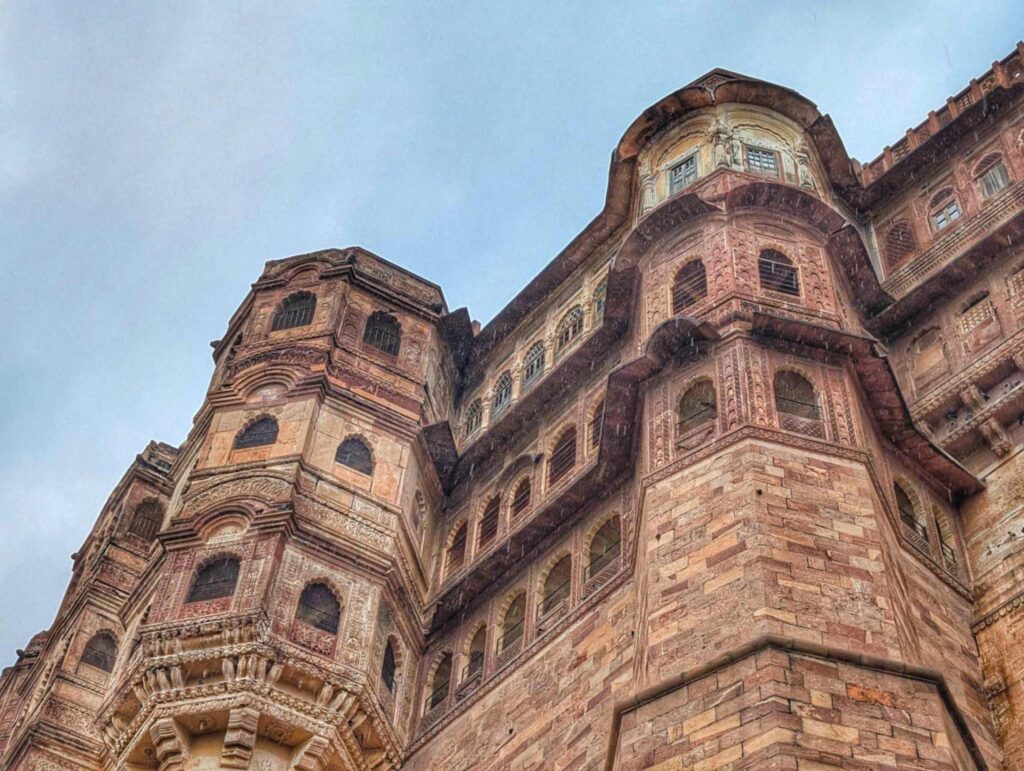
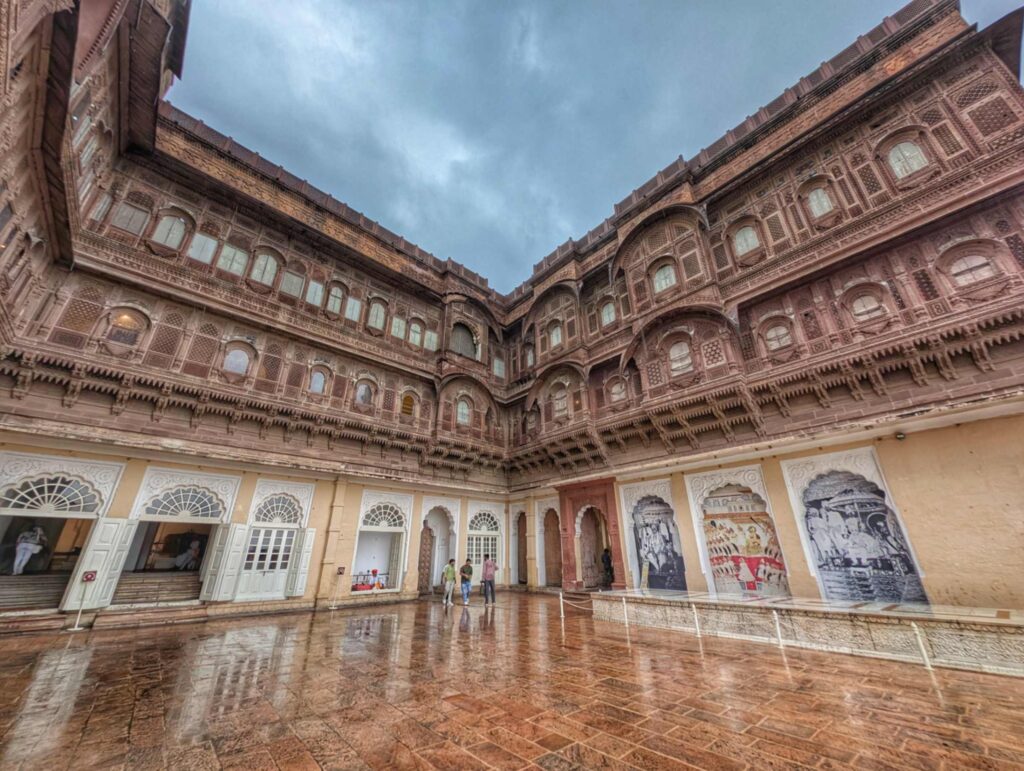
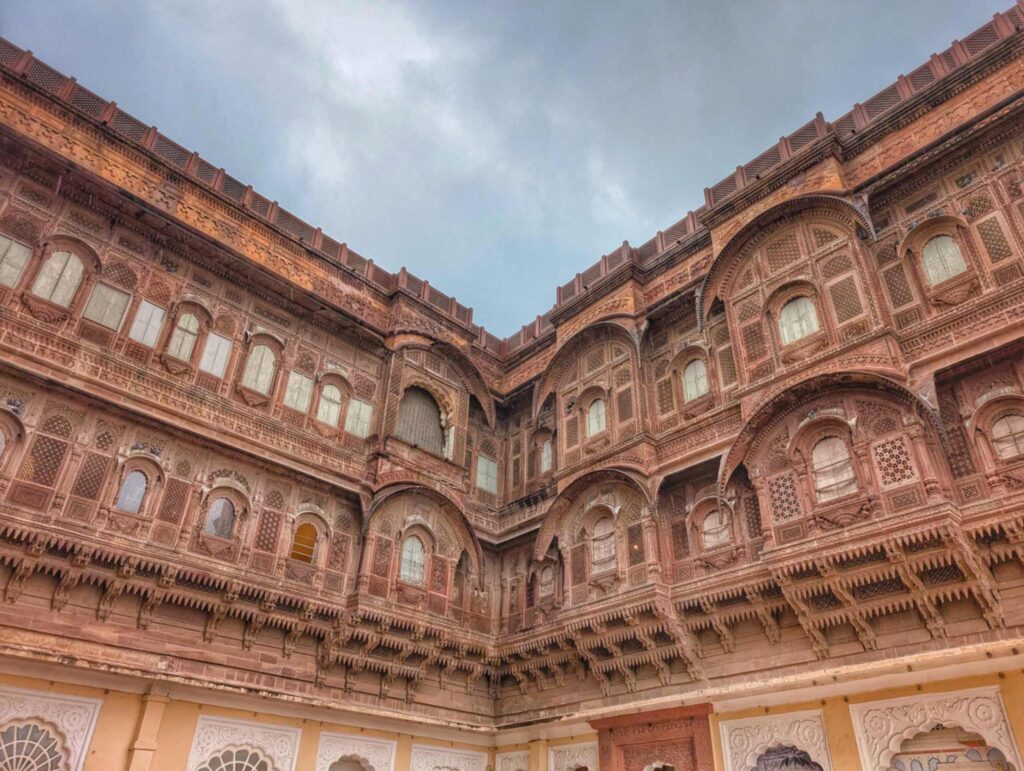
No visit to Jodhpur is complete without encountering the mighty Mehrangarh Fort.
But what they don’t mention in those glossy brochures are the spine-tingling legends that make this fort more dramatic than a Bollywood soap opera.
The Curse That Started It All
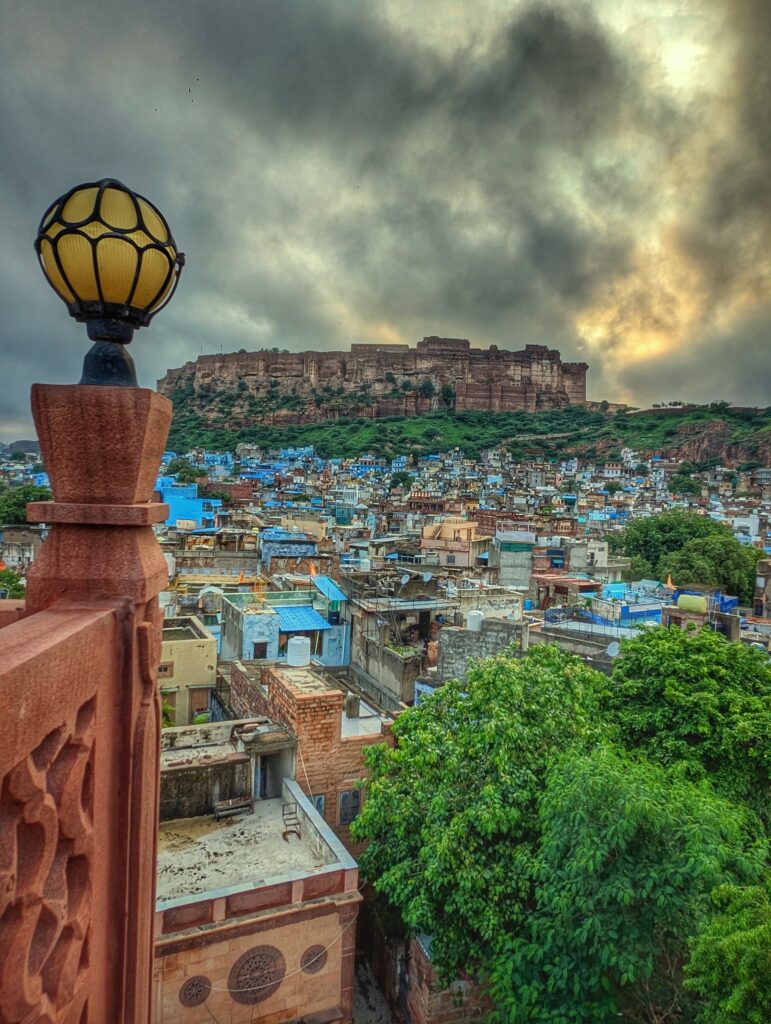
Picture this: the year was 1459, and Rao Jodha – think of him as the ambitious king with grand real estate plans – spotted this magnificent hill and thought, “Perfect! This is where I’ll build my dream fort!”.
The only problem? The hill already had a resident – a saint who was quite content living there .When Rao Jodha decided to evict this holy man for his construction project, the holy saint did what any angry saint would do – he cursed the kingdom with perpetual droughts.
Talk about the ultimate “You’ll regret this!” moment.But here’s where the story takes a darker turn. The only way to neutralize this curse? Human sacrifice in the fortifications!
And then enters a man whose selflessness puts all of us modern-day complainers to shame. He volunteered to be buried alive beneath the fort’s foundation to save the kingdom from eternal drought .
Standing there in the monsoon drizzle, I couldn’t help but think about the irony – here I was, complaining about slightly humid weather, while this man had literally given his life for his people.
The Sati Handprints – A Tale of Love and Loss
But wait, there’s more drama! As if the curse wasn’t enough, Mehrangarh Fort also houses one of history’s most haunting reminders of a practice that makes your heart heavy – the fifteen tiny handprints at the Loha Pol (Iron Gate).
These aren’t just random decorations. These gilded handprints were left by the wives of Maharaja Man Singh in 1843 as they prepared to join their husband in death through sati.
The women placed their hands on the gate as a final farewell before walking to the funeral pyre. The practice was so widespread that in 1731, six wives and fifty-eight concubines of Maharaja Ajit Singh had performed sati.
Standing before these handprints in the monsoon mist, I felt a chill that had nothing to do with the weather. These small imprints represent stories of women whose love was considered so sacred that death was preferable to widowhood.
The Secret Stone Path to Mehrangarh
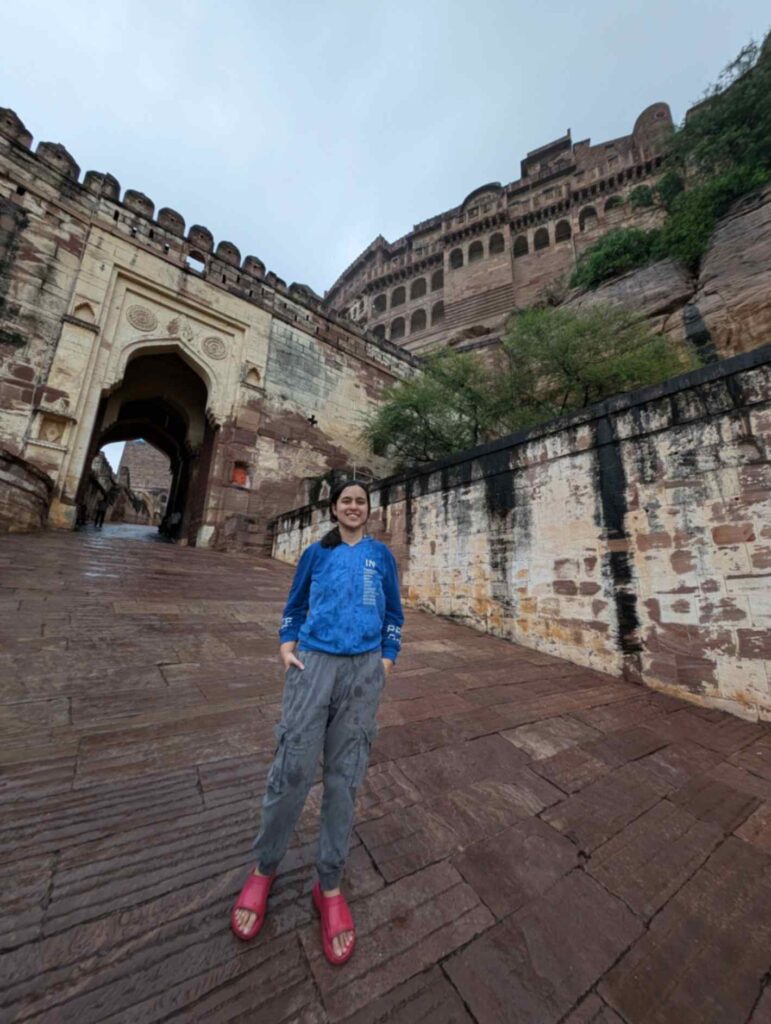
Now, here’s something most tourists miss – there’s a special stone path at the back of Mehrangarh Fort that offers a completely different perspective of the city.
While everyone crowds the main entrance like bargain hunters at a sale, I chose to go to the fort by this route.
This path is like the fort’s best-kept secret. The stone pathway winds its way up the hill, offering breathtaking views of the Blue City below, especially during monsoon when everything looks refreshingly green.
It’s steep, but the workout is worth it. Plus, you avoid the tourist crowds and get to feel like you’re discovering something special.
Ancient Artefacts of Mehrangarh
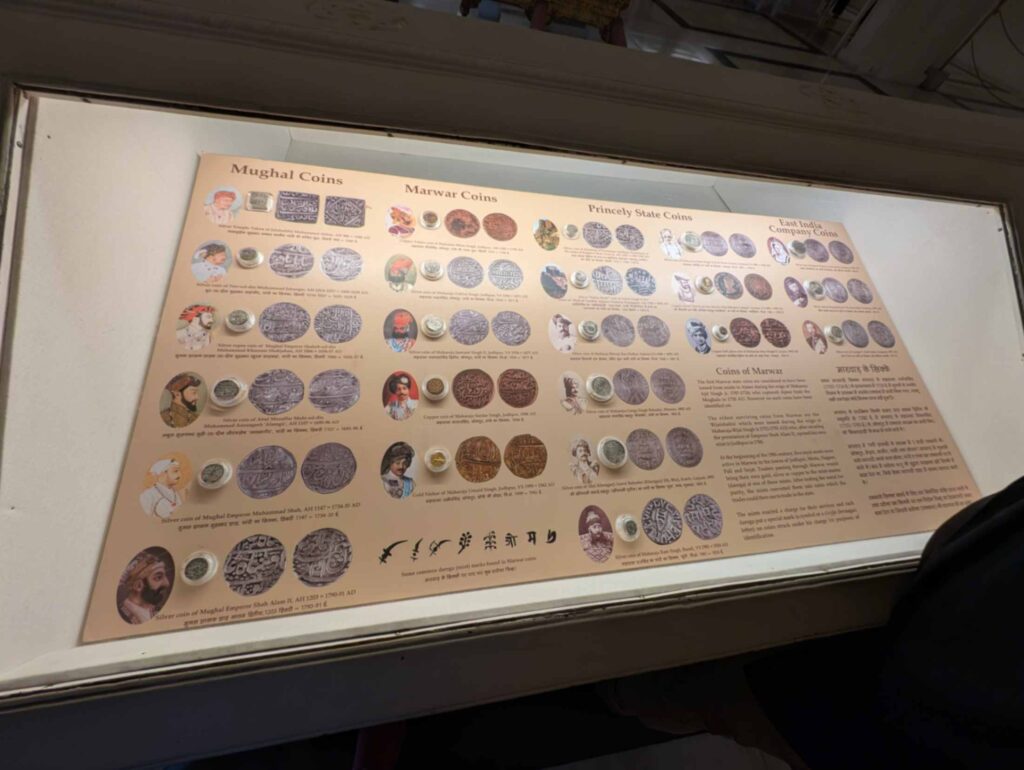
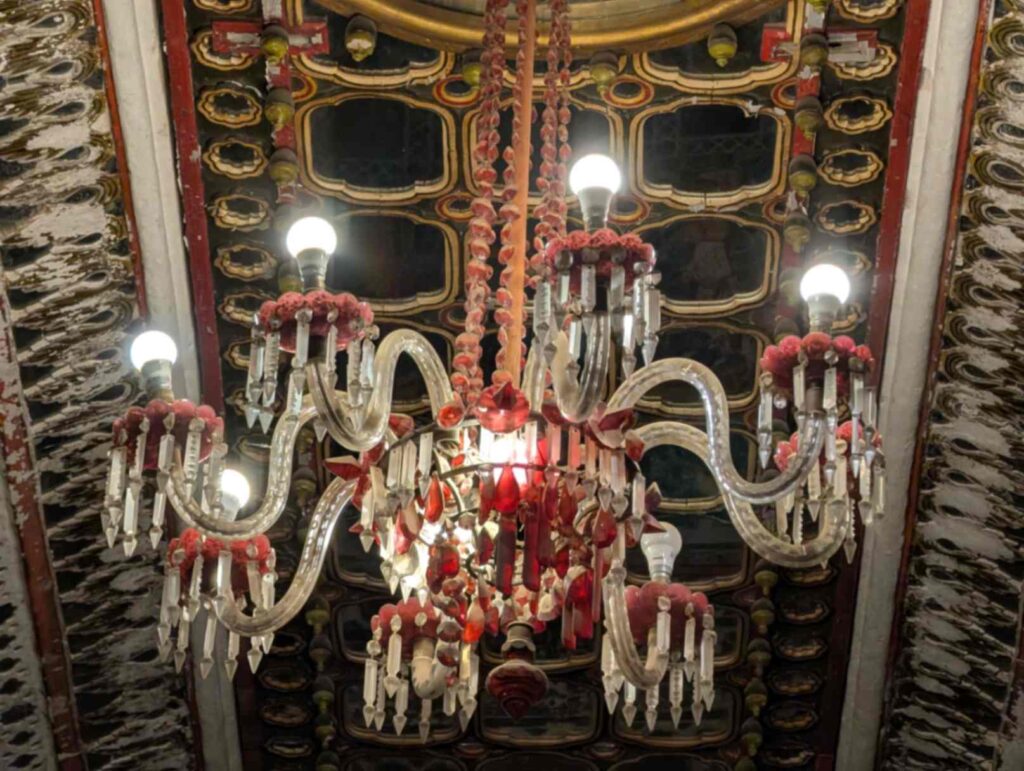
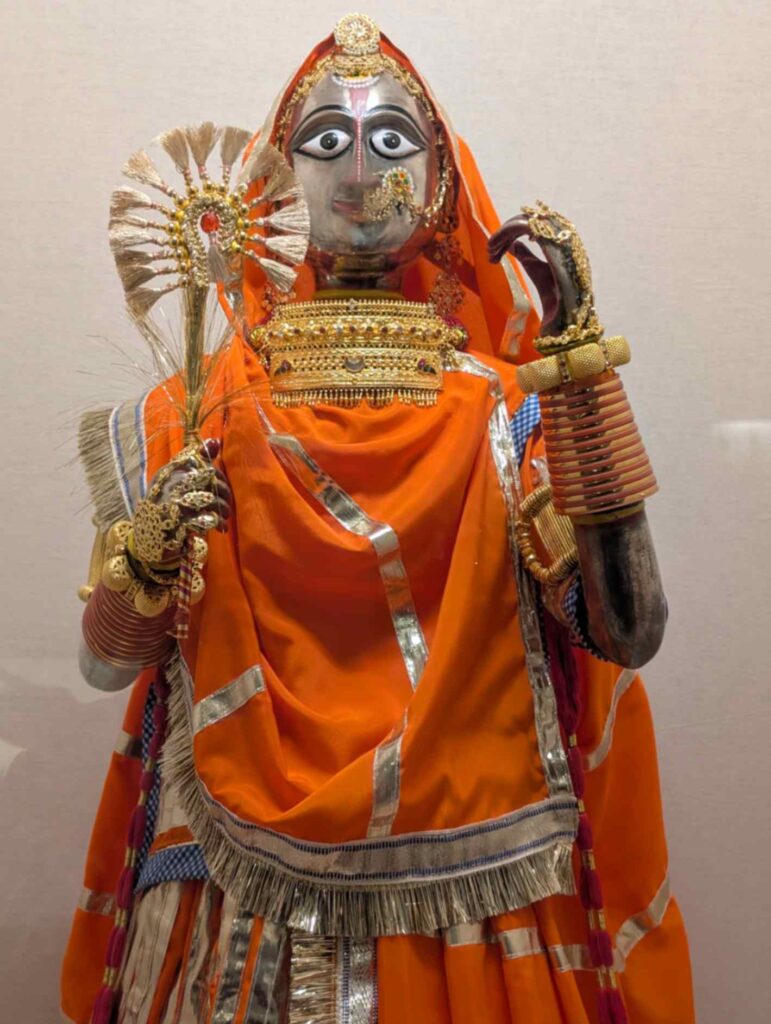
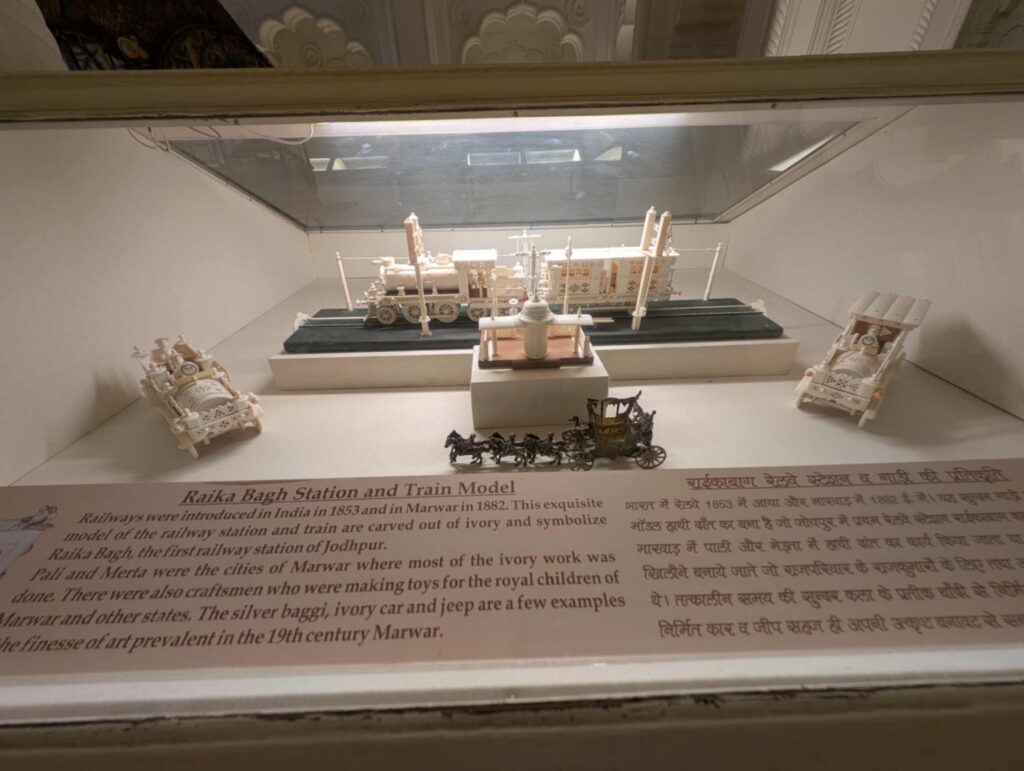
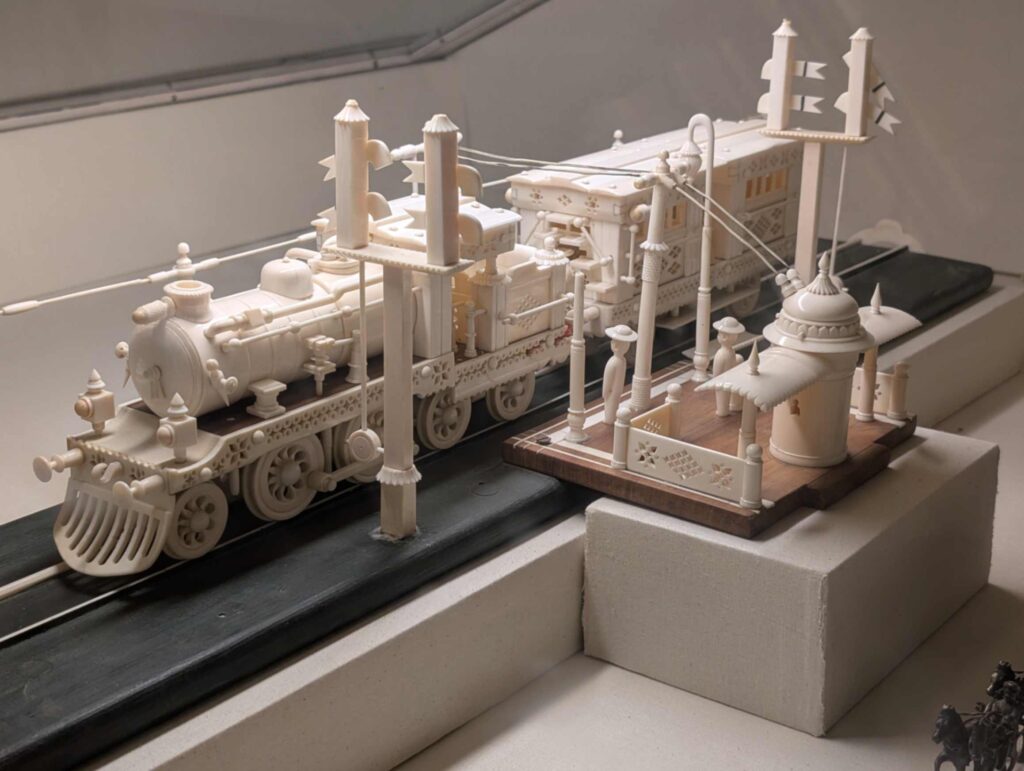
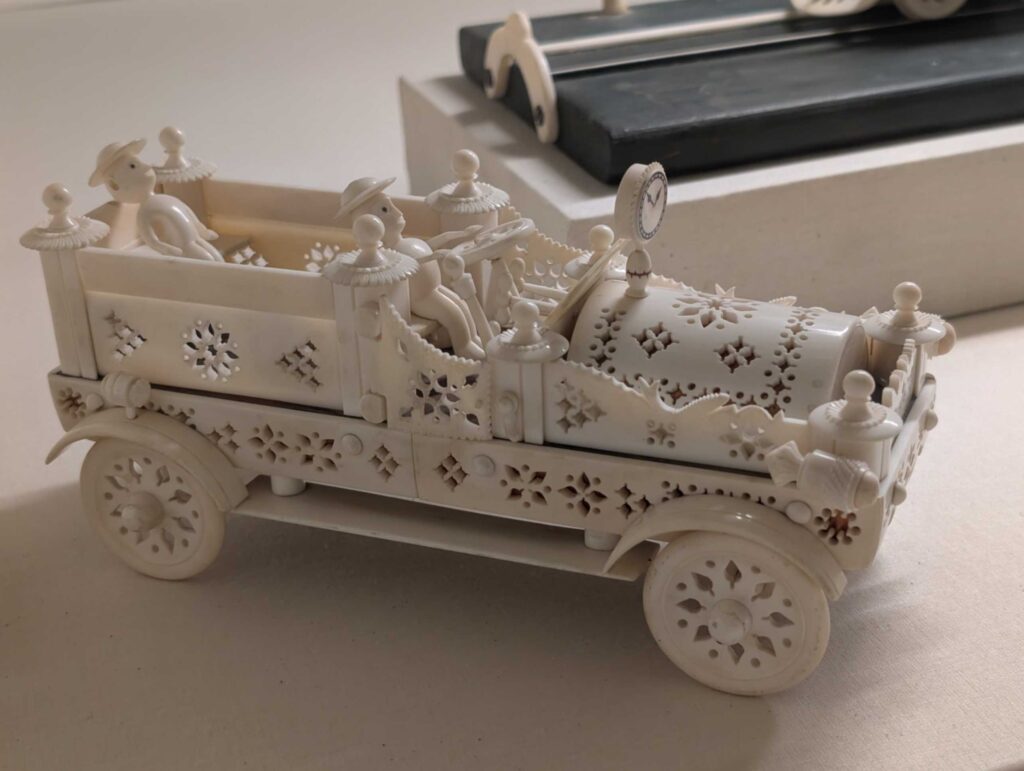
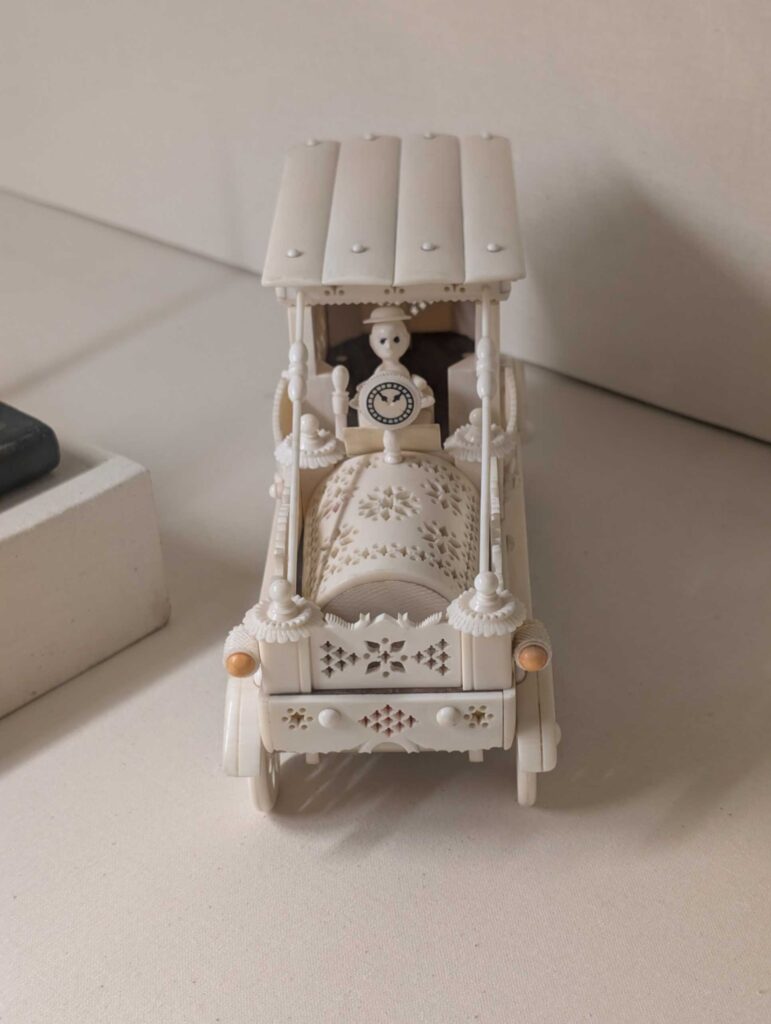
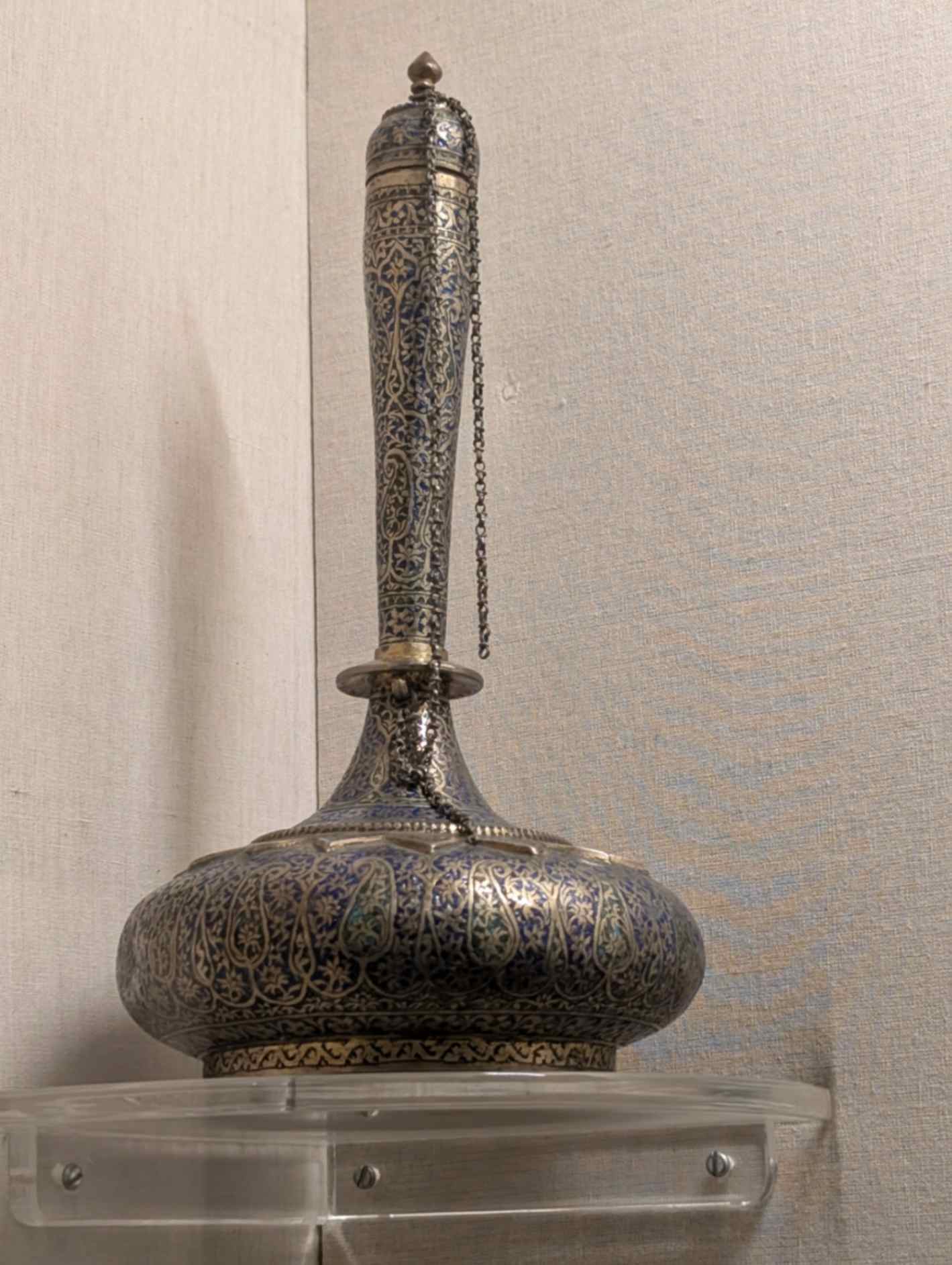
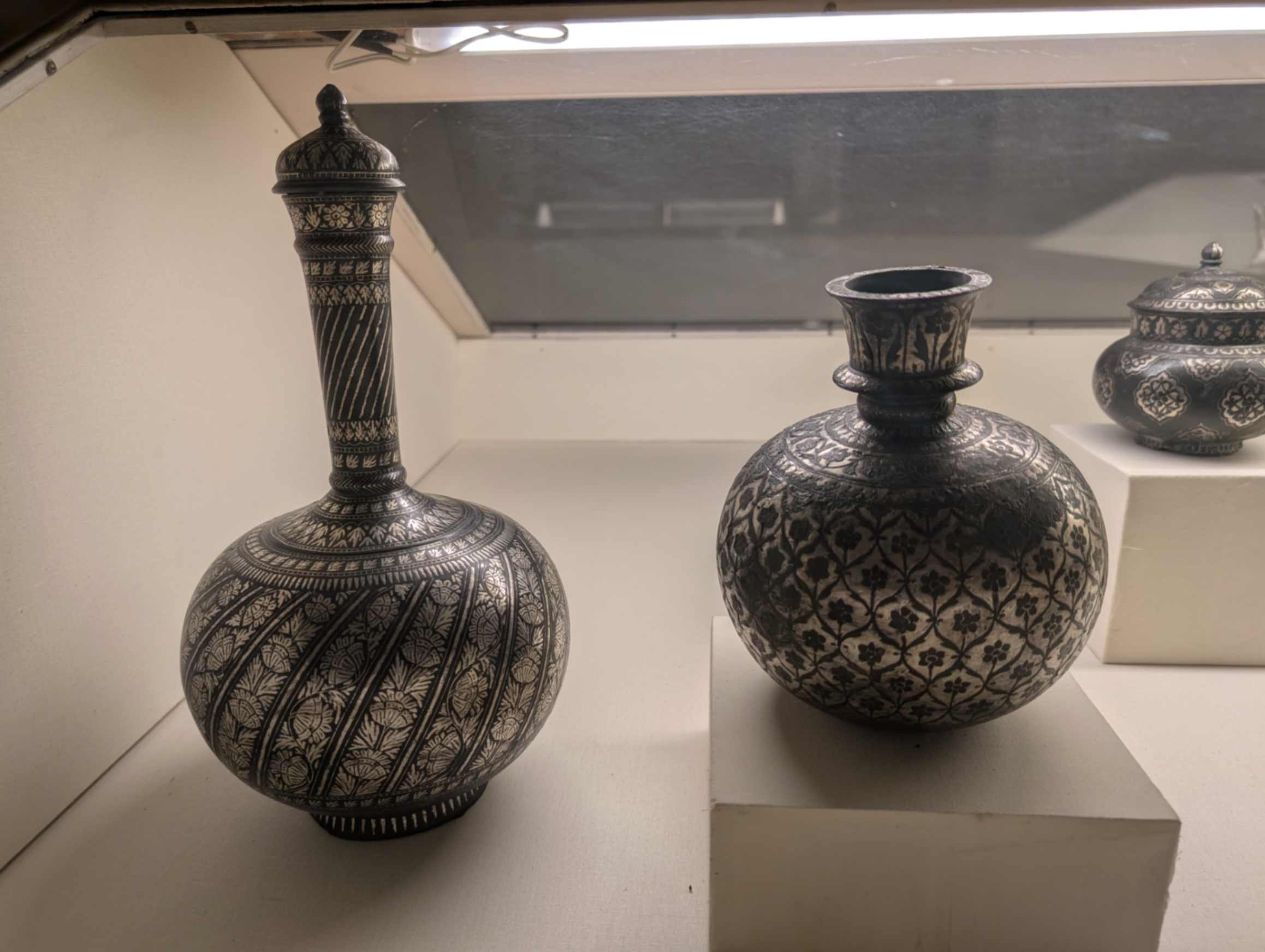
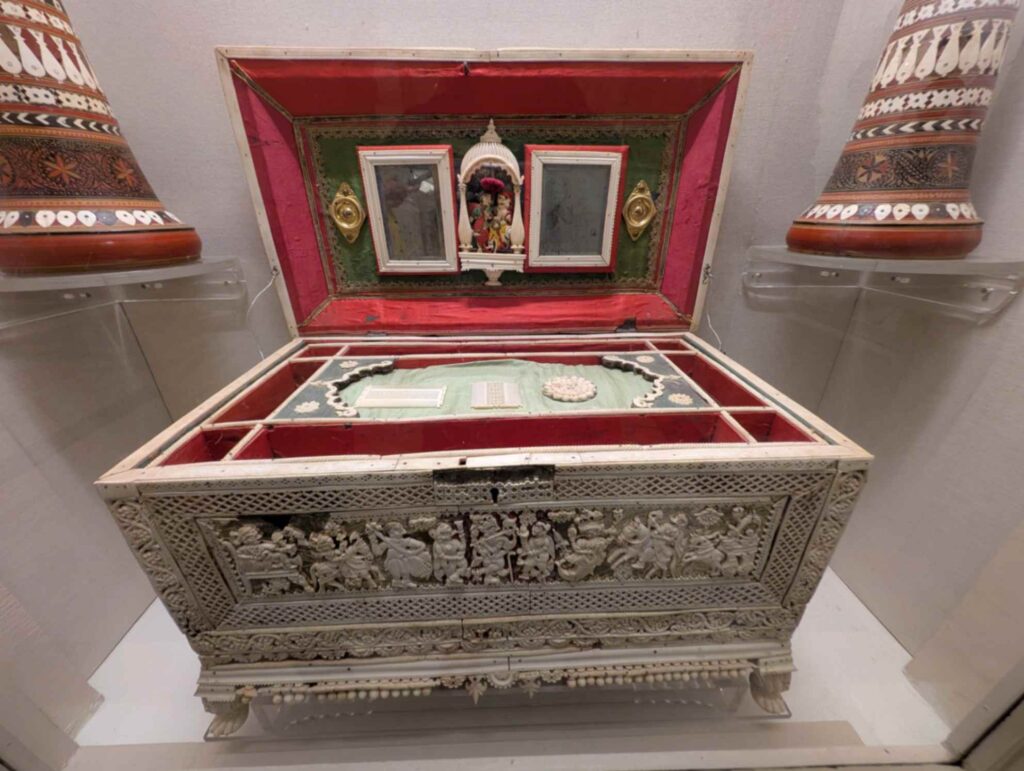
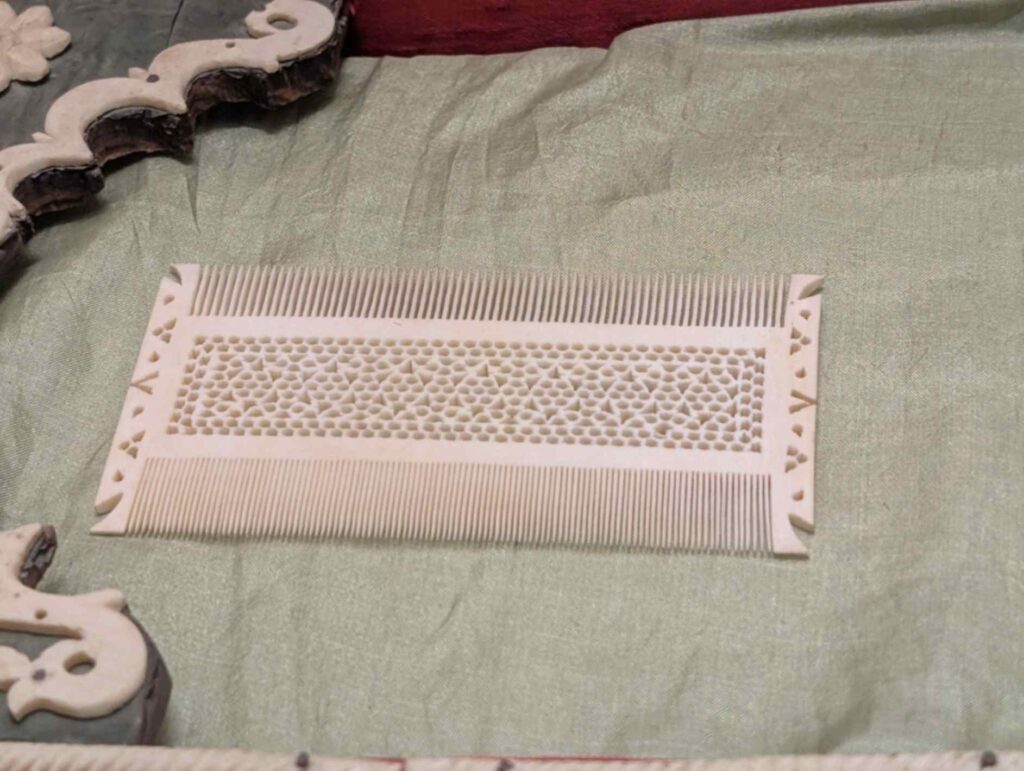
The Monsoon Food Trail – A Culinary
Now, let’s talk about the real reason I survived this monsoon adventure – the food!
Jodhpur during the rainy season turned out to be a foodie’s paradise, mainly because the weather actually made it pleasant to walk from one food stall to another without melting into a puddle.
Janta Sweets Kachori
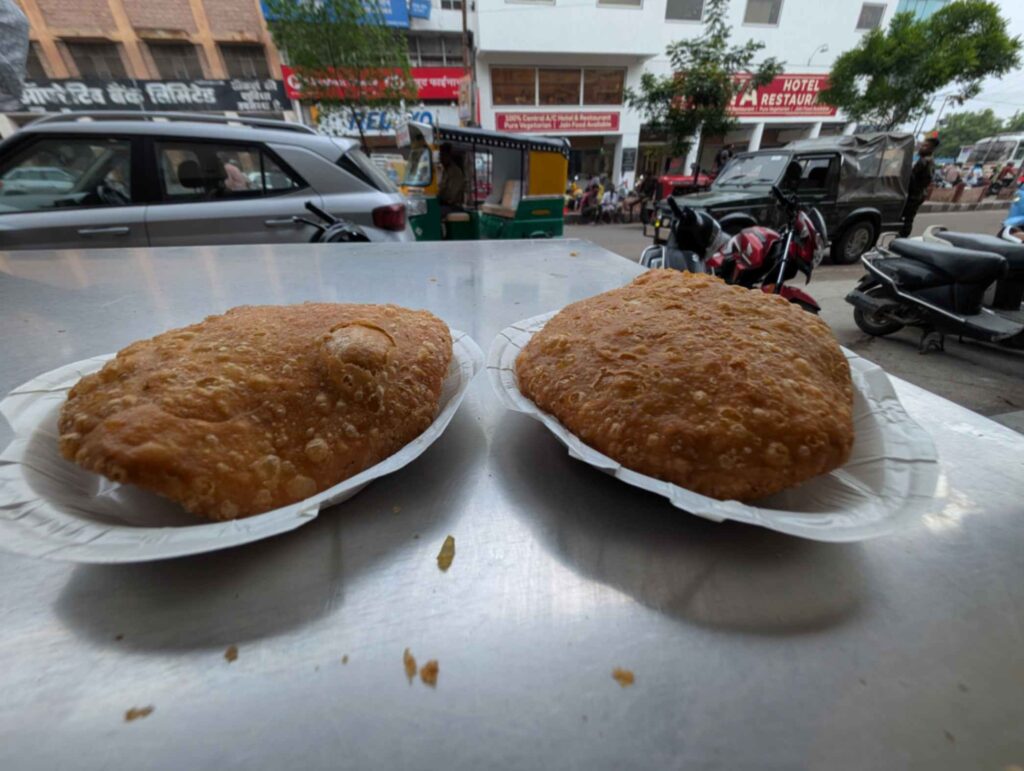
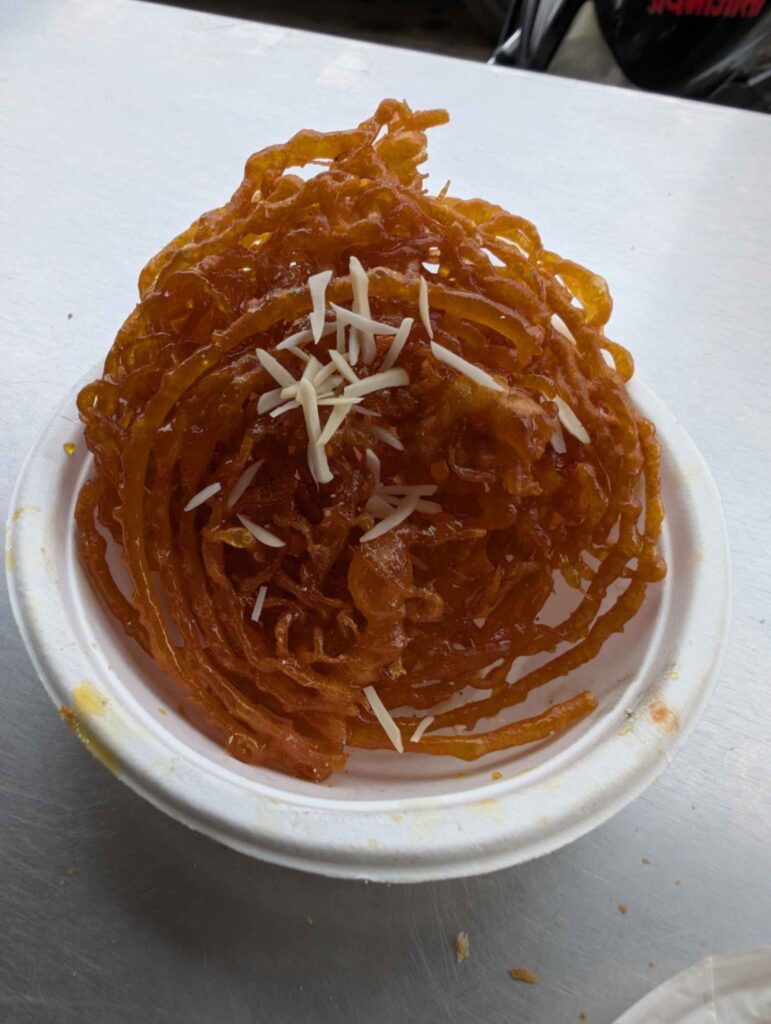
My first food stop was Janta Sweet Home, and let me tell you, this place should come with a warning label: “Highly Addictive – May Cause Serious Kachori Dependency.” Their pyaz ki kachori (onion kachori) and mawa kachori were so good that it made my day.
The place is constantly surrounded by locals, which is always a good sign. It’s like a mob scene, but instead of protesting, everyone’s just really excited about deep-fried goodness.
The kachoris are the size of small burgers and each bite is a flavor explosion that makes you question why you ever ate anything else.
Shahi Samosa – The Royal Treatment
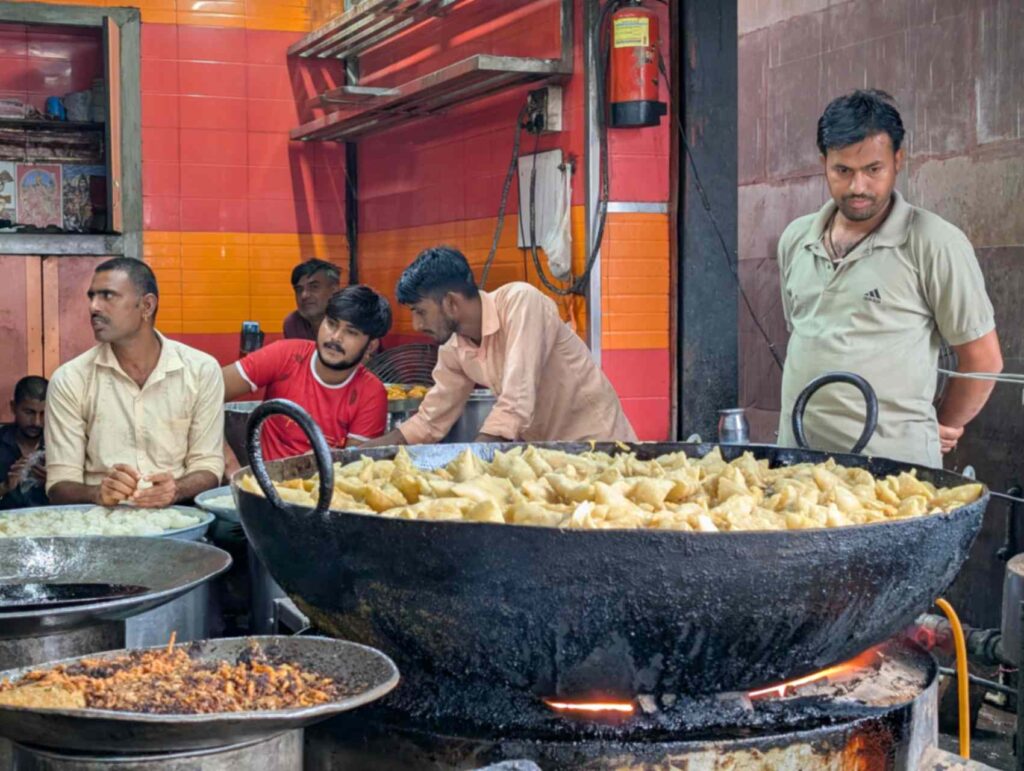
Next on my monsoon food tour was the legendary Shahi Samosa. Located near the Clock Tower, this place serves samosas that are so loaded with dry fruits and spiced potato masala, they should probably come with their own throne.
Watching them prepare these golden triangles of happiness was like witnessing a culinary magic show. The oil might look questionable to health-conscious folks (let’s just say it’s been well-seasoned by previous batches), but the taste? Absolutely divine.
Sometimes you have to trust the process, even when the process looks like it defies every food safety rule you’ve ever learned.
Shri Mishrilal’s Lassi – The Creamy Cloud of Heaven
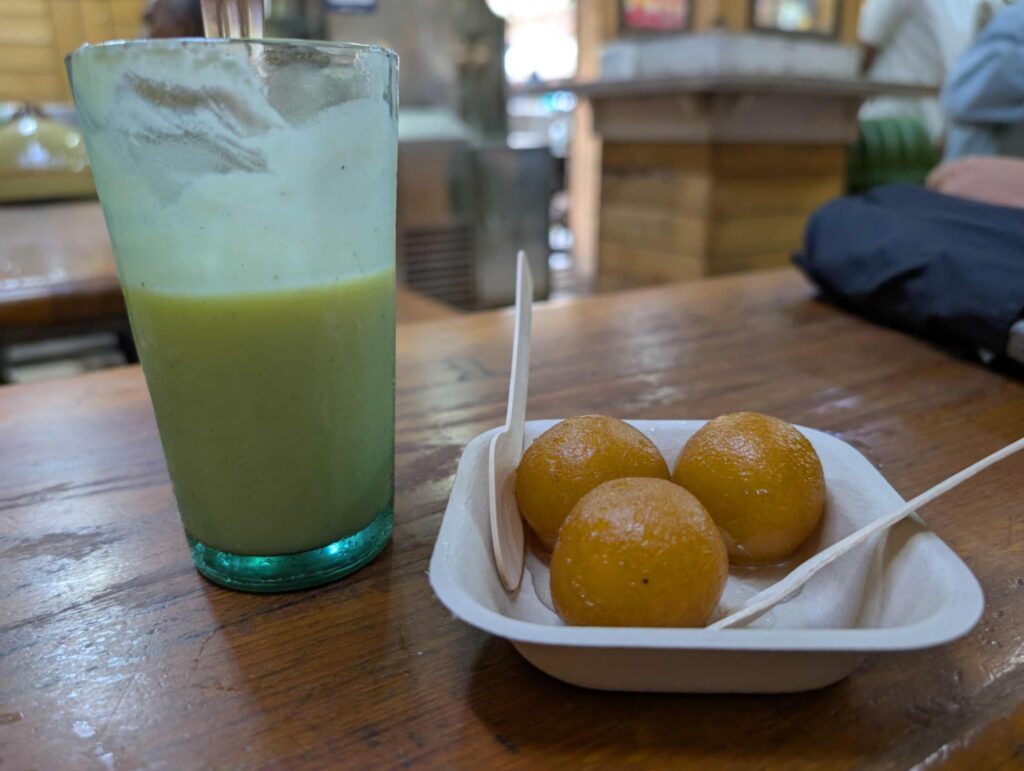
If there’s one thing you absolutely cannot miss in Jodhpur, it’s the Makhaniya Lassi at Shri Mishrilal Hotel. This 90-year-old establishment near the Clock Tower serves lassi. Their pedha and gulab jamun were equally spectacular.
The pedha was so perfectly sweet and crumbly, that my partner bought extra boxes to take back home.
Lal Maas at Gopal Rooftop – Spice, Views, and Drama
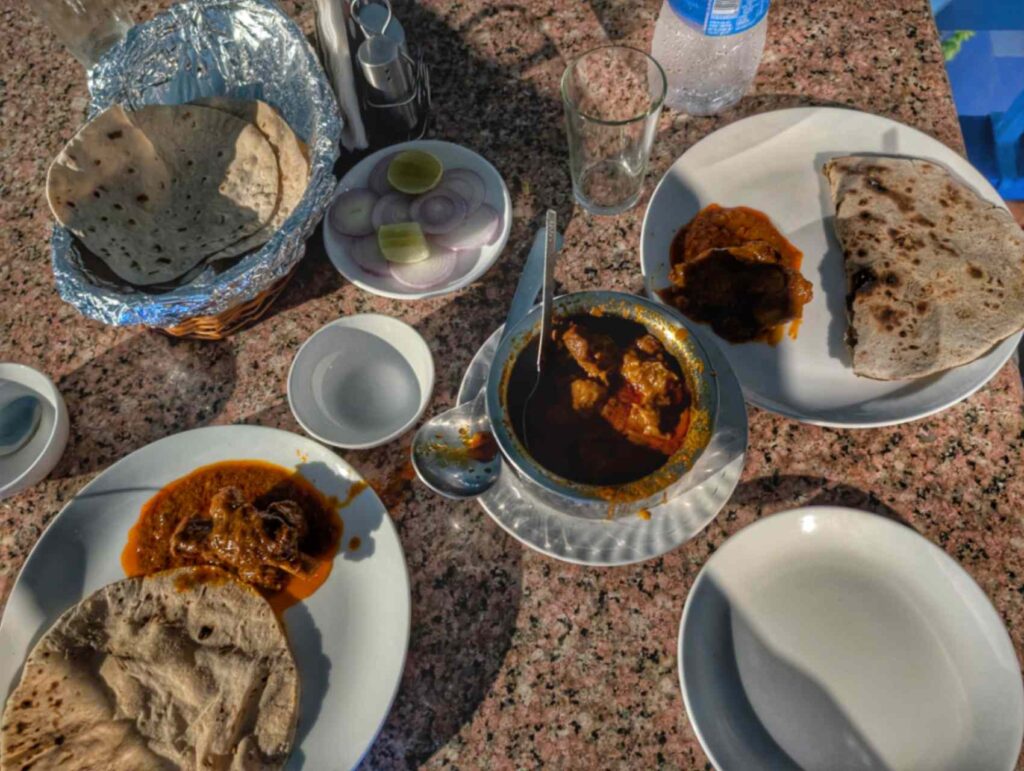
For my non-vegetarian adventure, I climbed up to Gopal Rooftop Restaurant for their famous Lal Maas. This place offers a spectacular view of Mehrangarh Fort, especially magical during monsoon evenings when the fort is shrouded in dramatic clouds.
The Lal Maas (red meat curry) here is the stuff of legends. It’s spicy enough to make you question your life choices, but delicious enough to keep you going back for more.
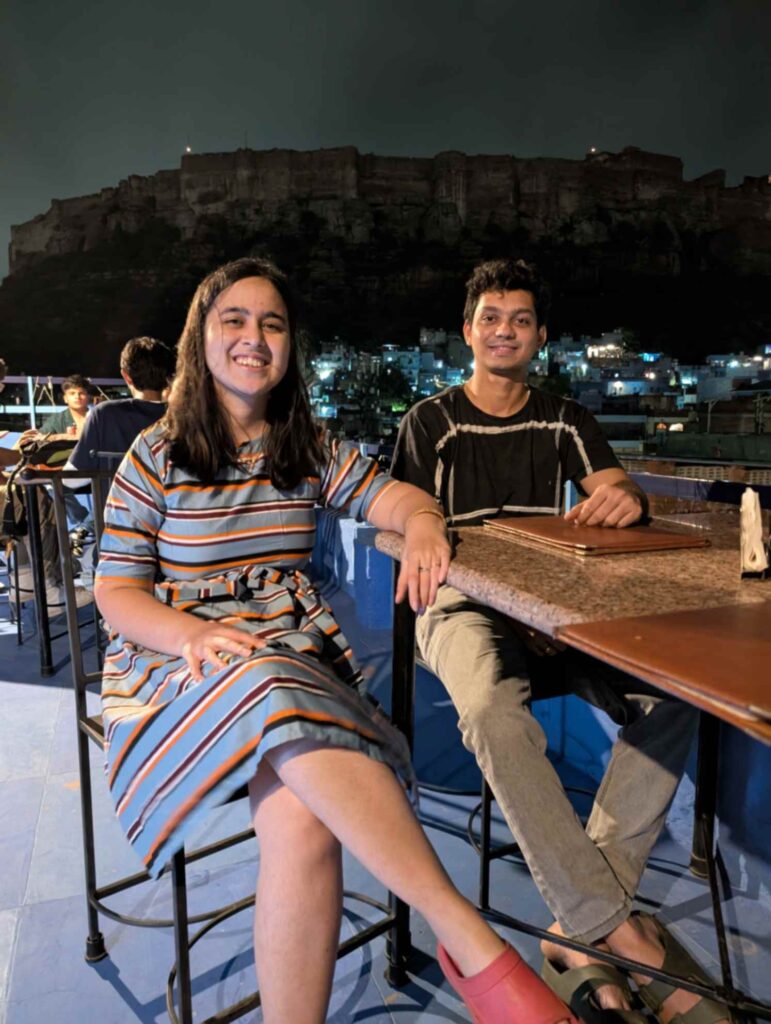
The restaurant’s owner is quite the character – he’ll not only serve you great food but also insist on taking your photos until he’s satisfied with the shots. It’s like dinner and a photography session rolled into one!
Bhawani Dal Bati Churma – The Royal Trio
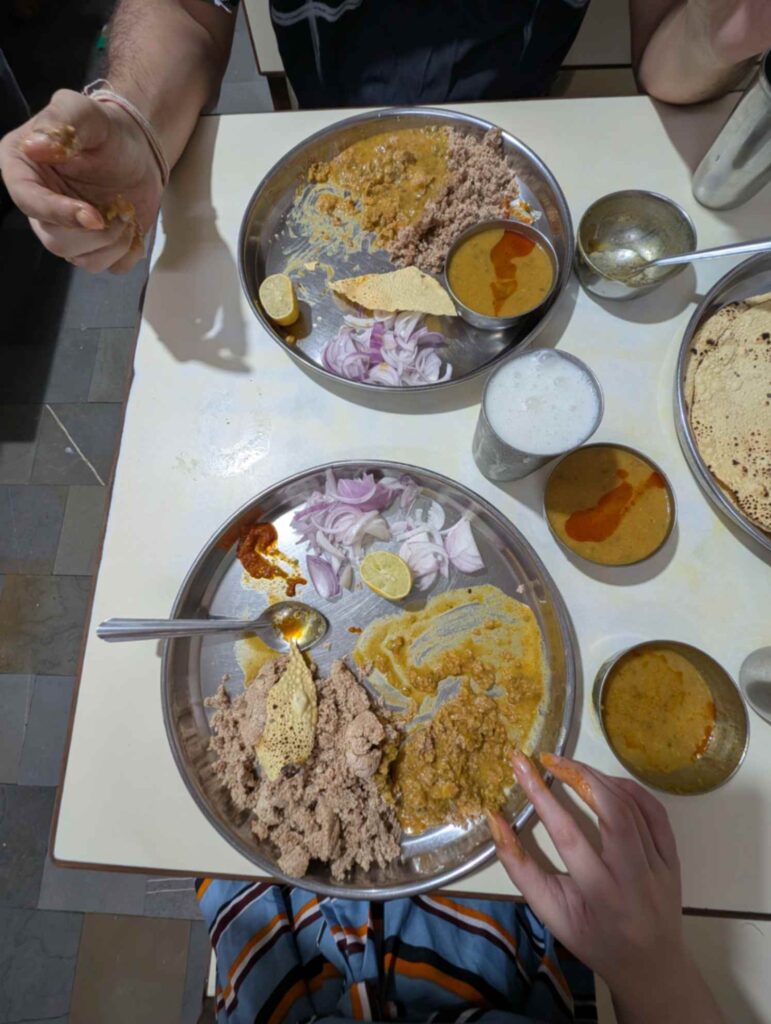
No Jodhpur food experience is complete without Dal Bati Churma, and Bhawani Dal Bati Churma serves it like it’s meant to be eaten – with passion and zero regard for calories.
The dal bati churma is essentially Rajasthan’s answer to the perfect comfort meal. The bati (wheat balls) are baked until they’re crispy outside and soft inside, the dal is rich and flavorful, and the churma (sweet crumble) is the perfect dessert ending.
It’s carb-loading at its finest, and after all that walking through the Blue City, I felt I’d earned every delicious bite.
Exploring the The Blue City Jodhpur in Monsoon
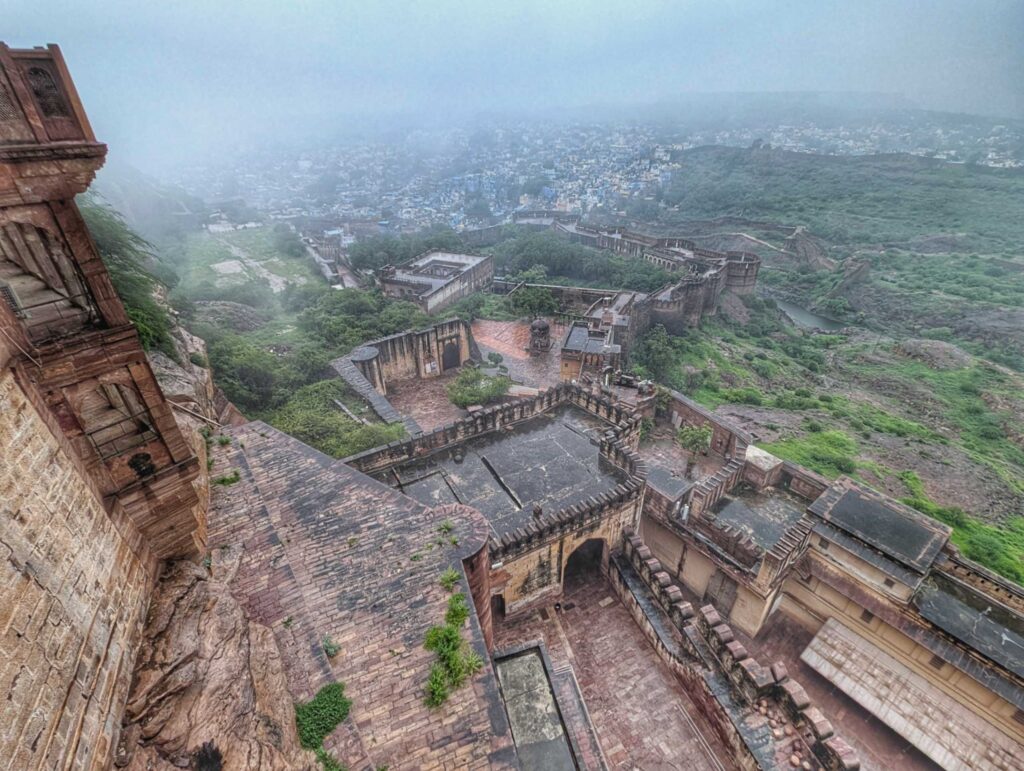
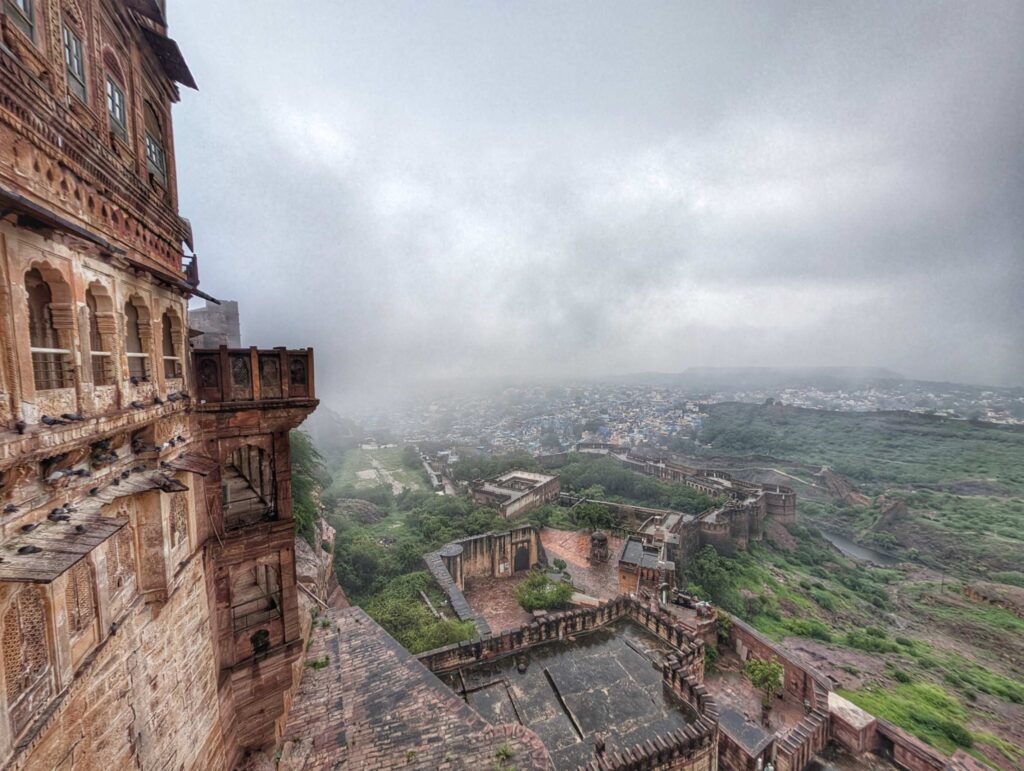
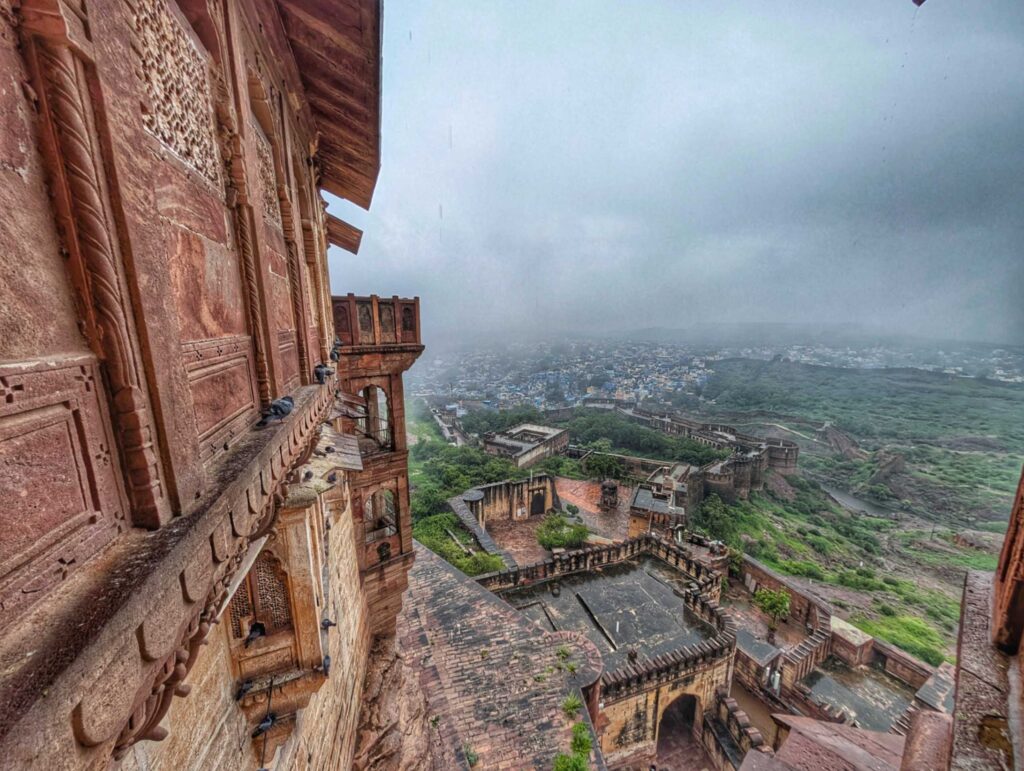
The beauty of visiting Jodhpur during monsoon is that you get to see a side of Rajasthan that most people never experience.
The usual dusty, scorching desert transforms into something surprisingly green and refreshing.
The temperatures during monsoon hover between 25°C to 37°C, which, compared to the usual 45°C+ summer heat, feels like nature’s own air conditioning.
The humidity does spike, but it’s a fair trade-off for being able to walk around the city without feeling like you’re slowly roasting.
The rain brings out colors in Jodhpur that you’d never expect. The blue houses look more vibrant, the sandstone of Mehrangarh Fort gleams like gold, and even the usually parched landscape around the city turns surprisingly lush.
It’s like someone adjusted the saturation settings on real life.
As I sat on my hotel rooftop one evening, watching the monsoon clouds gather around Mehrangarh Fort, I realized something profound.
Sometimes the best travel experiences come from doing exactly what everyone tells you not to do.
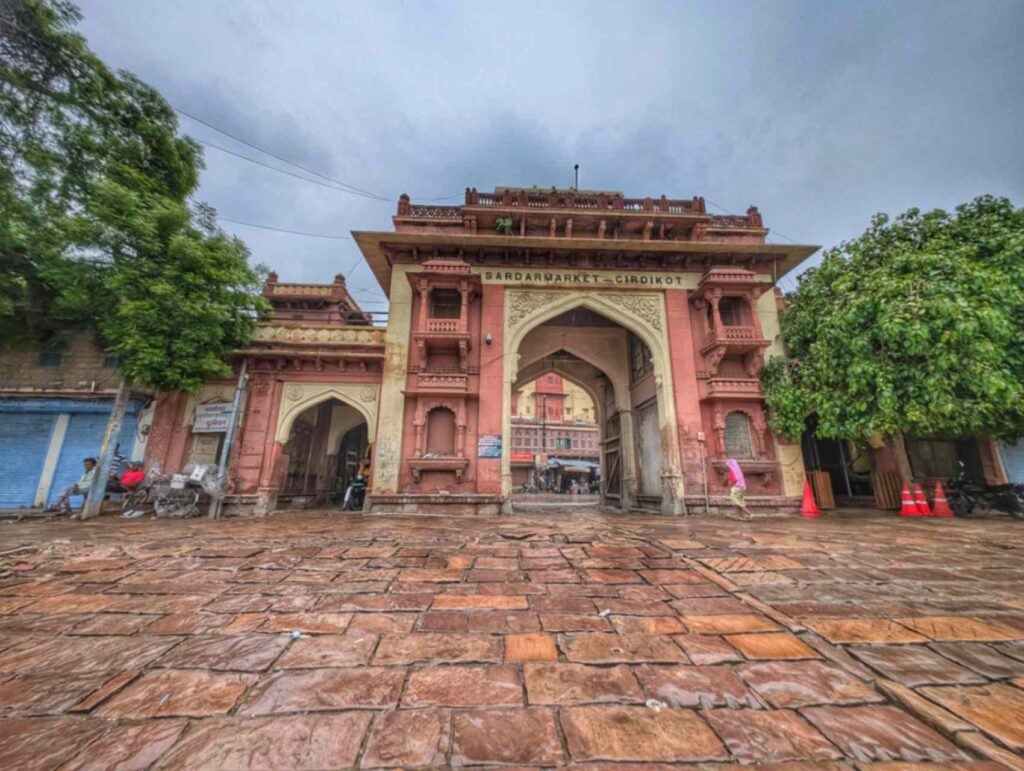
Jodhpur in monsoon isn’t just about avoiding the crowds or getting better hotel deals (though both are nice perks).
It’s about seeing a city transform, about walking through rain-washed streets that sparkle like jewels, about eating hot kachoris while cool raindrops fall on your head, and about feeling like you’ve discovered a secret that nobody else knows.
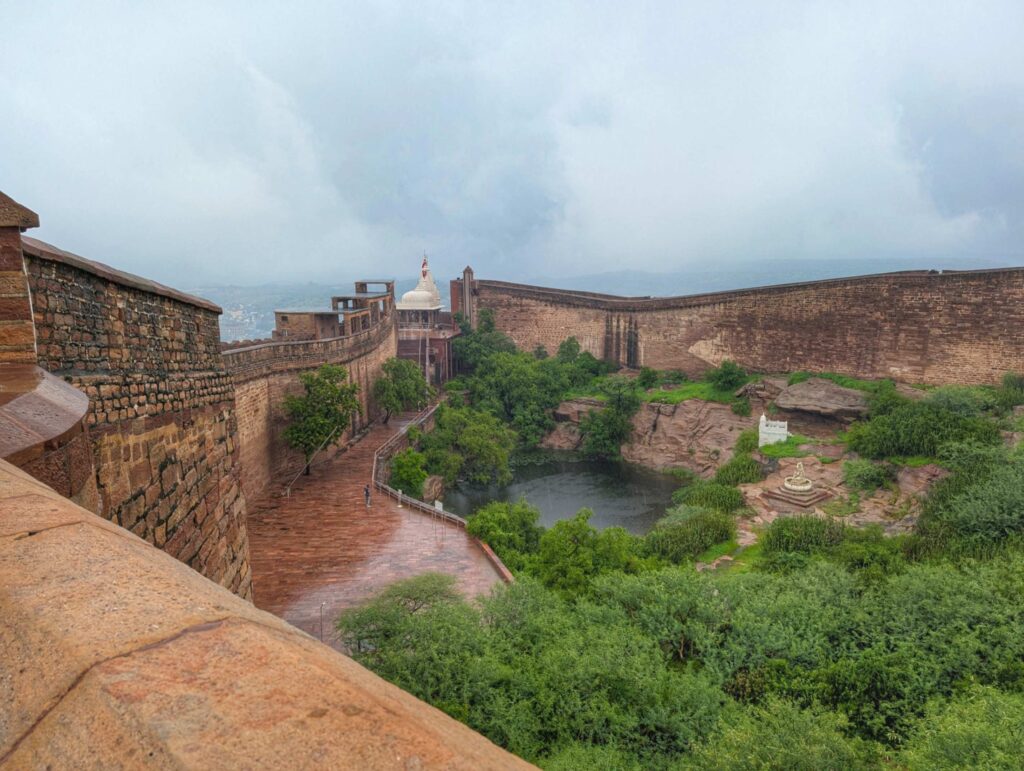
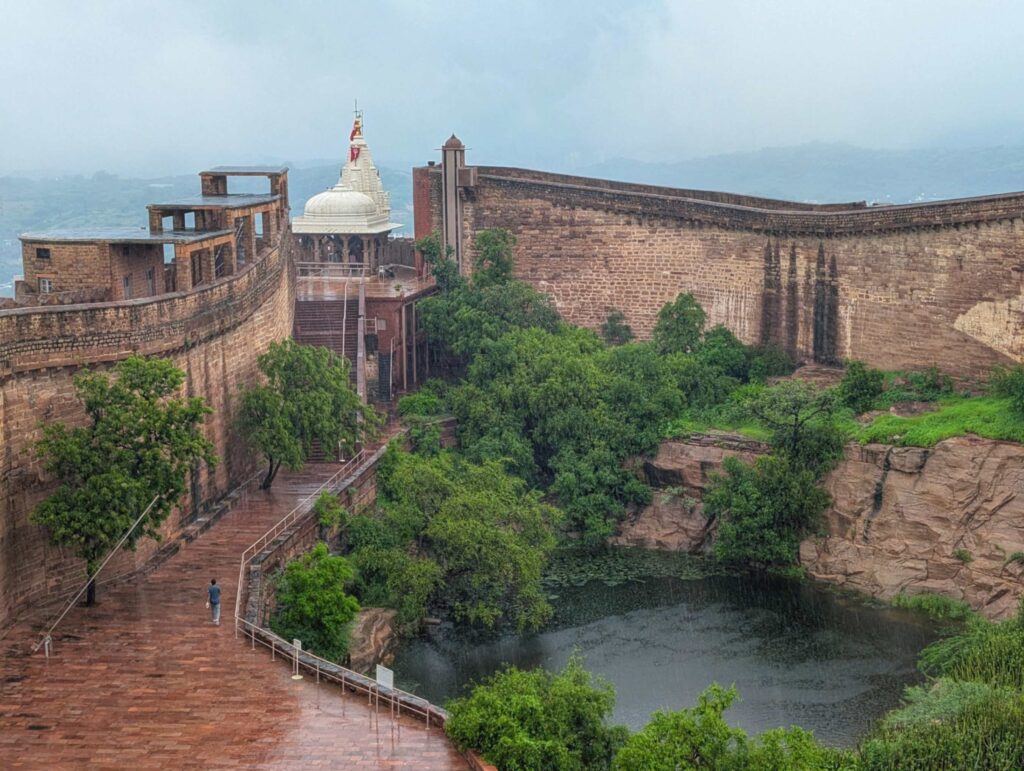
The legends of Mehrangarh Fort feel more atmospheric when told during a monsoon evening with thunder providing the background score. The curse of the sage and the tragic handprints of the sati wives somehow seem more poignant when experienced in the dramatic setting that only monsoon weather can provide.
One of the best discoveries of my trip was realizing that Jodhpur is incredibly walkable.
From my base at Kankaria Heritage, I could walk to every major attraction – the Clock Tower, the Blue City lanes, Toorji ka Jhalra stepwell, and even the base of Mehrangarh Fort & Jaswant Thada.
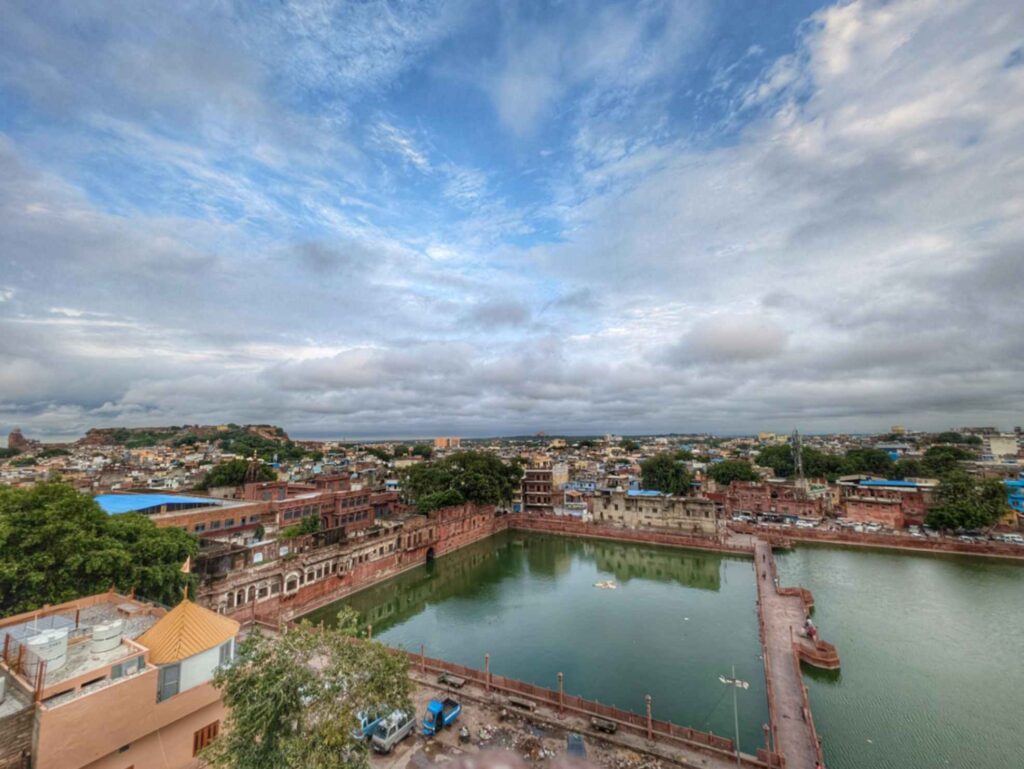
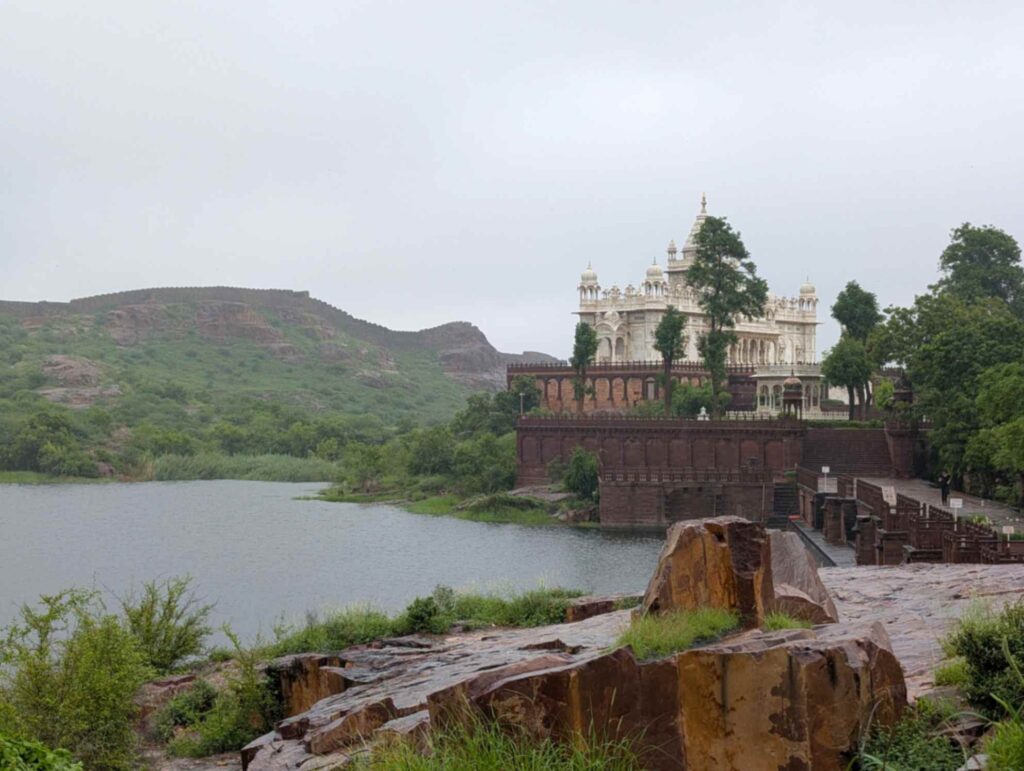
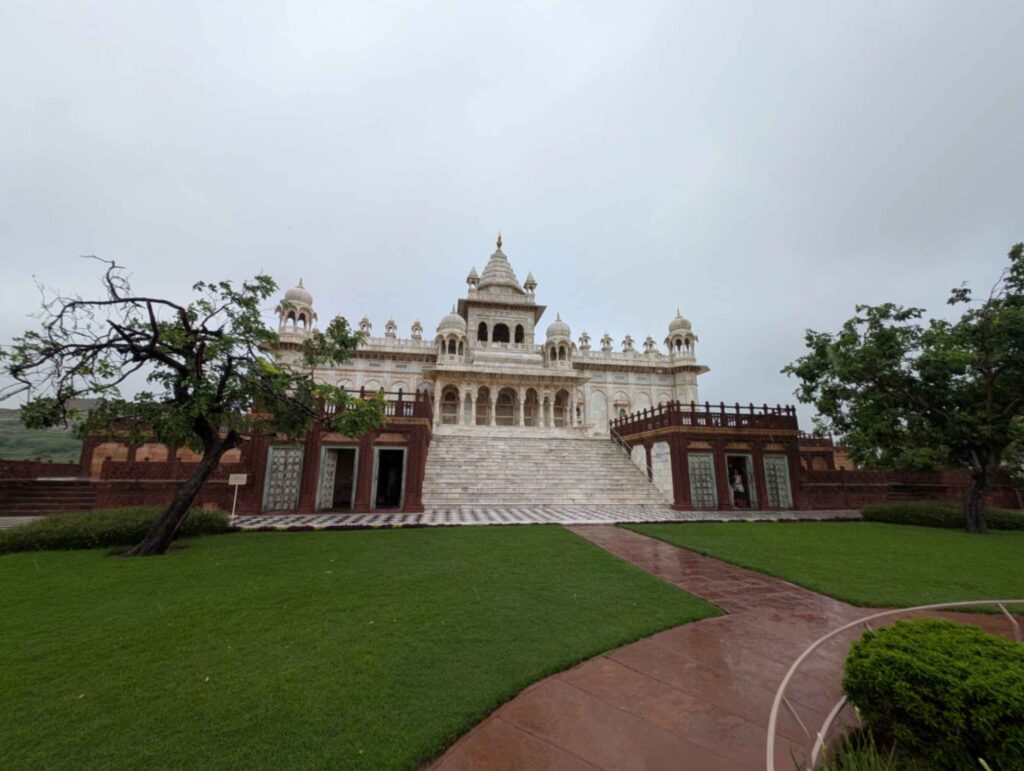
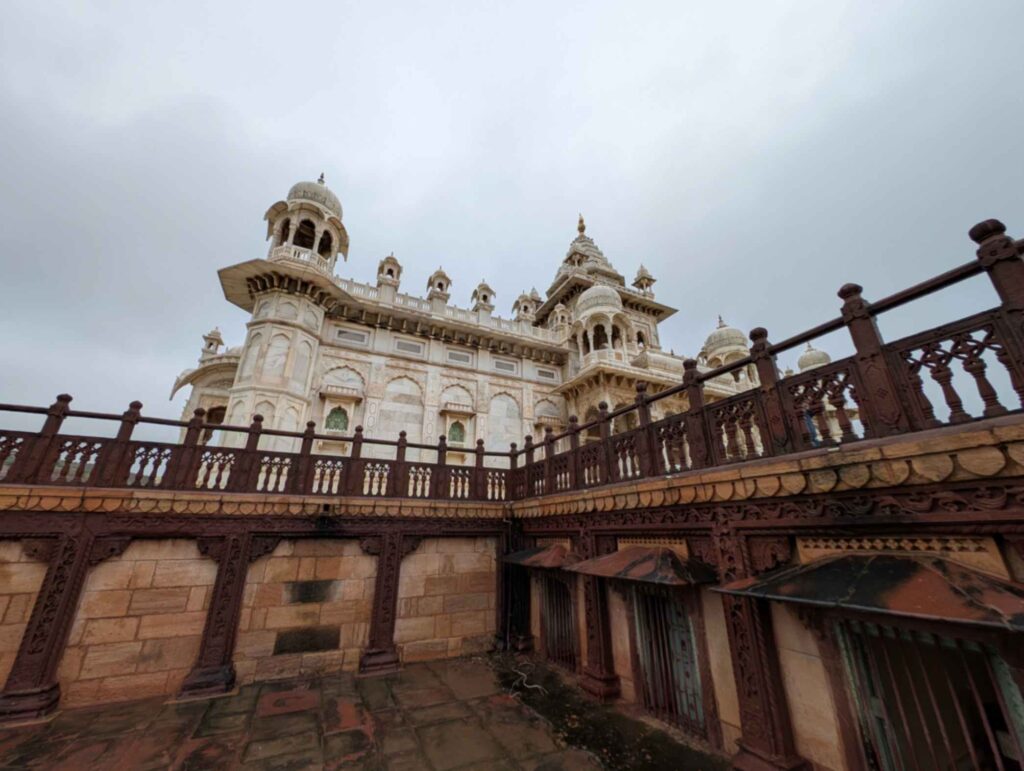
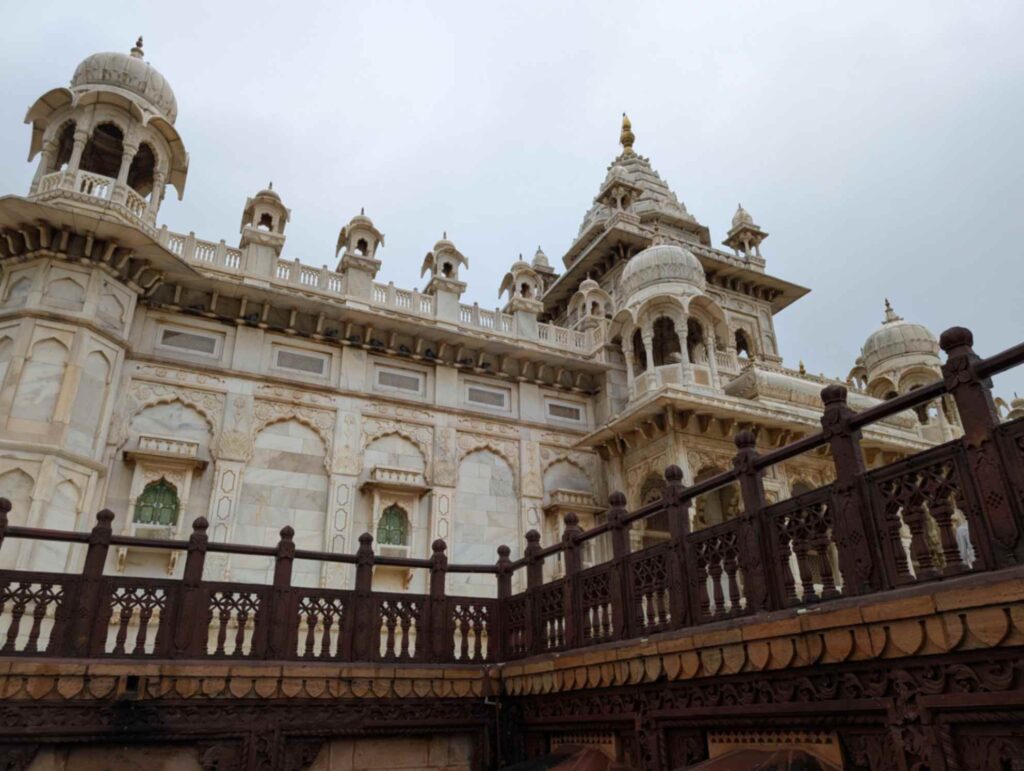

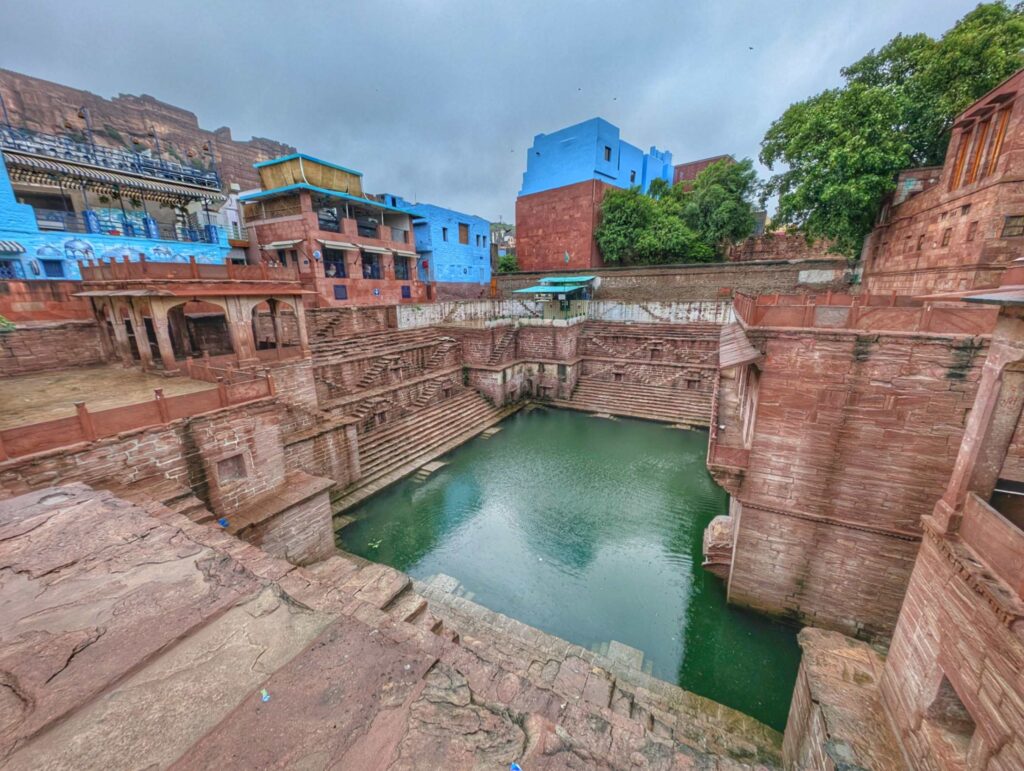
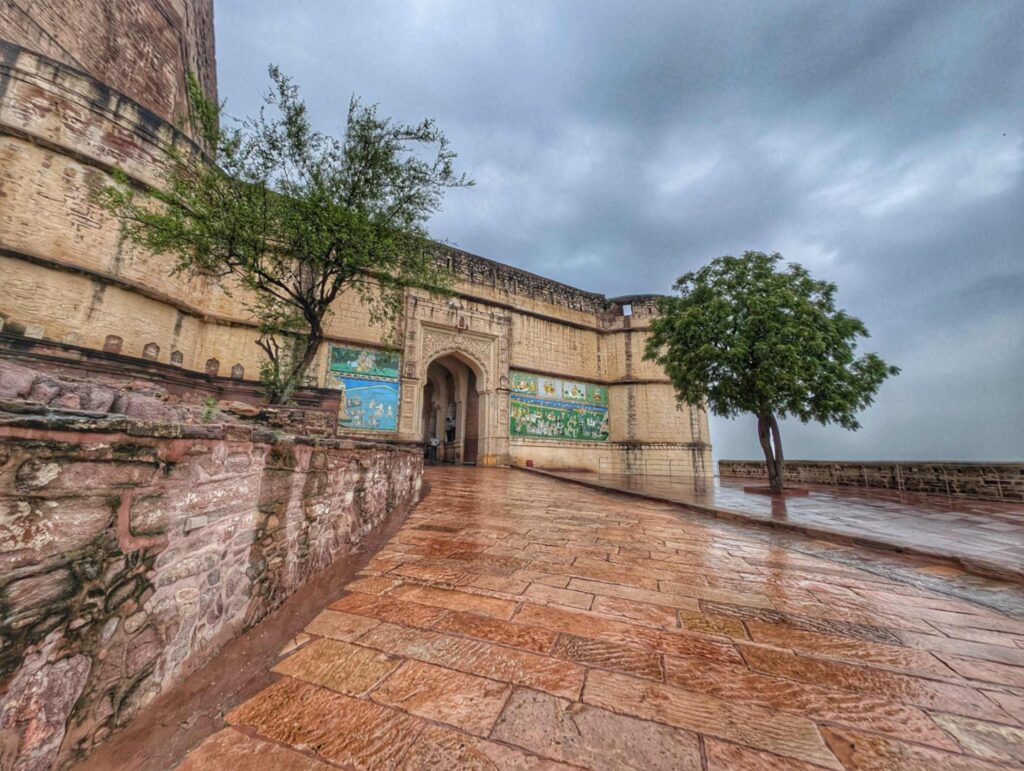
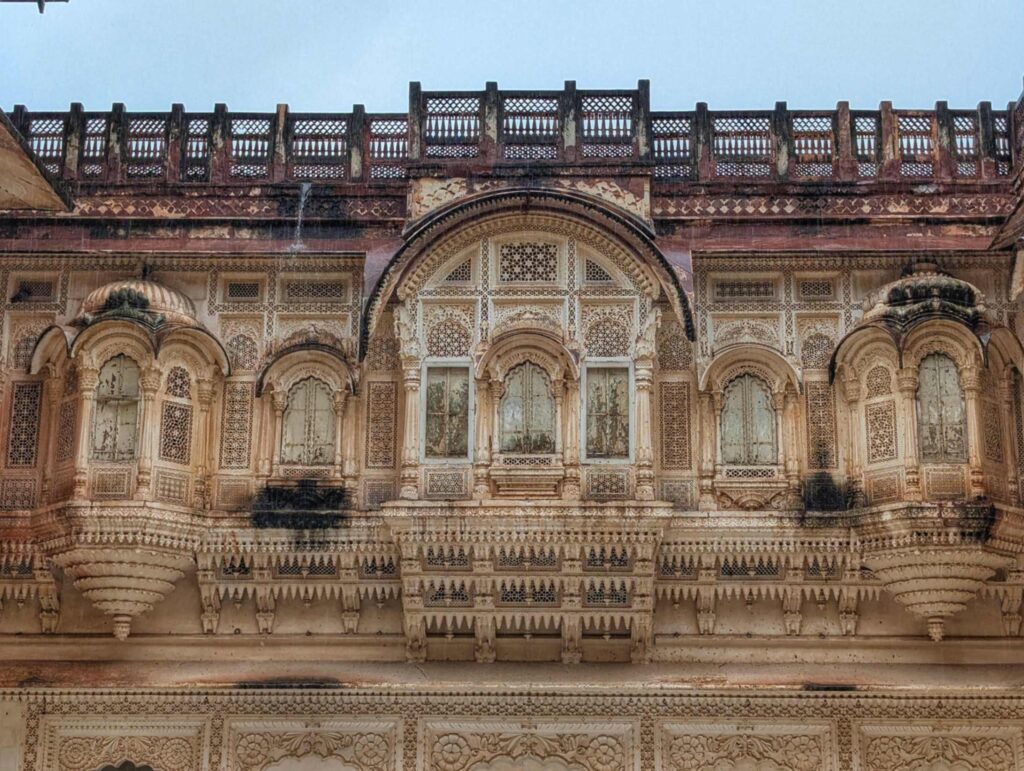
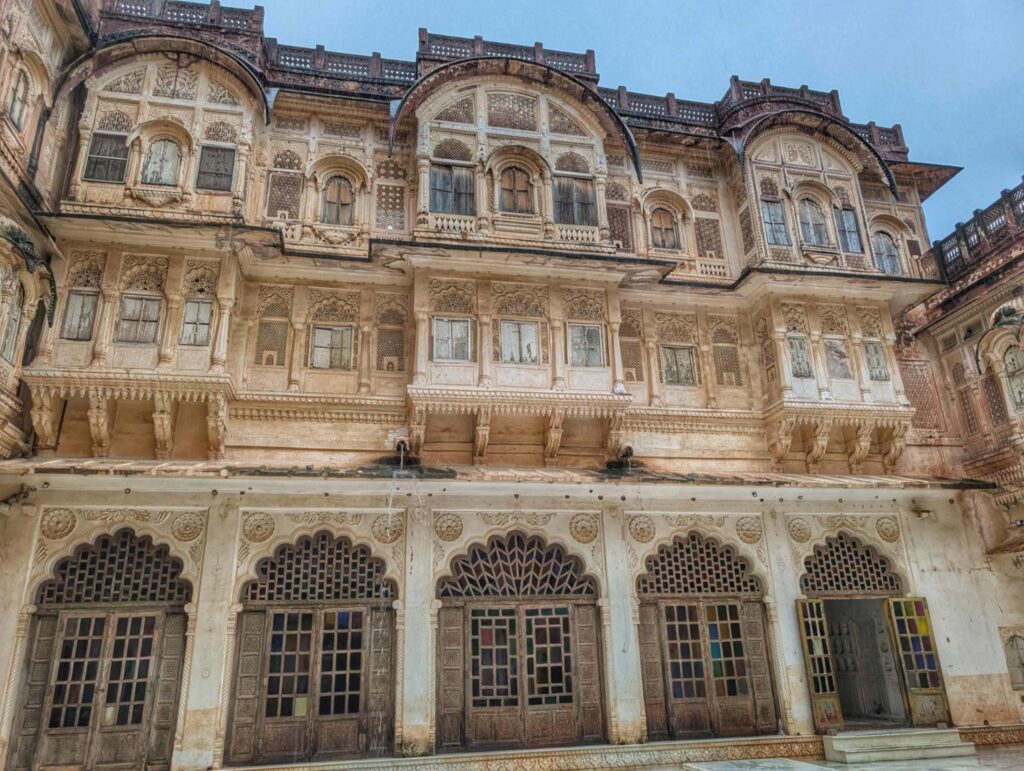
The only two places in Jodhpur which are not accessible by walk are :
- Umaid Bhawan Palace
- Mandore Garden
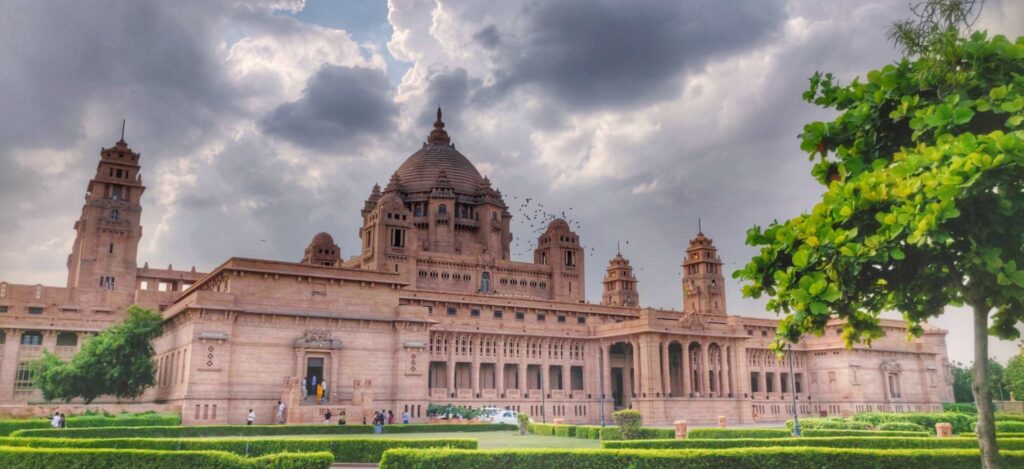
The morning heritage walks starting from the Clock Tower are particularly magical during monsoon. The air is clean, the streets are washed, and there’s something incredibly romantic about exploring ancient blue lanes while monsoon clouds gather overhead.
The stone path behind Mehrangarh became my go-to route for accessing the fort. Not only did it help me avoid the tourist crowds, but it also offered some of the most spectacular views of the city, especially when rain clouds created dramatic backdrops for photography.
You know that magical Bollywood moment when a song just sticks with you forever? Well, “Mhare Hiwda Mein Naache Mor” isn’t just any song. It was actually shot during the rainy season right inside the majestic Mehrangarh Fort here in Jodhpur!
Yes, those iconic rugged sandstone walls you see towering over the city are not just historic landmarks, they’re also the gorgeous backdrop to one of my childhood’s favorite tunes from Hum Saath Saath Hain.
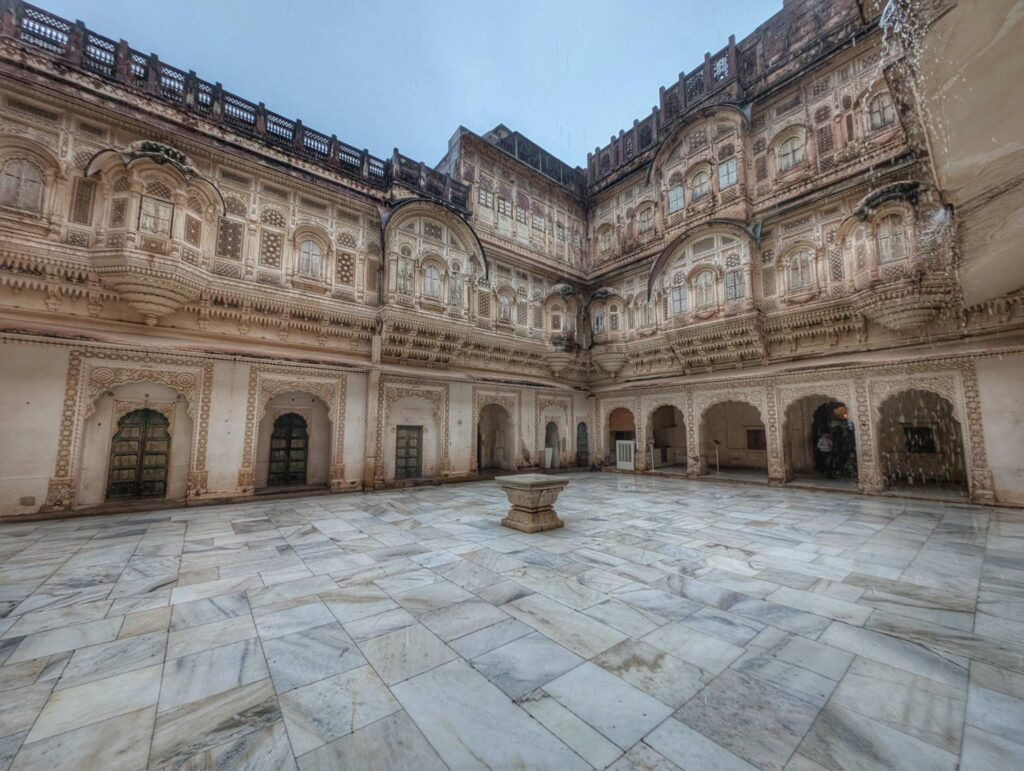
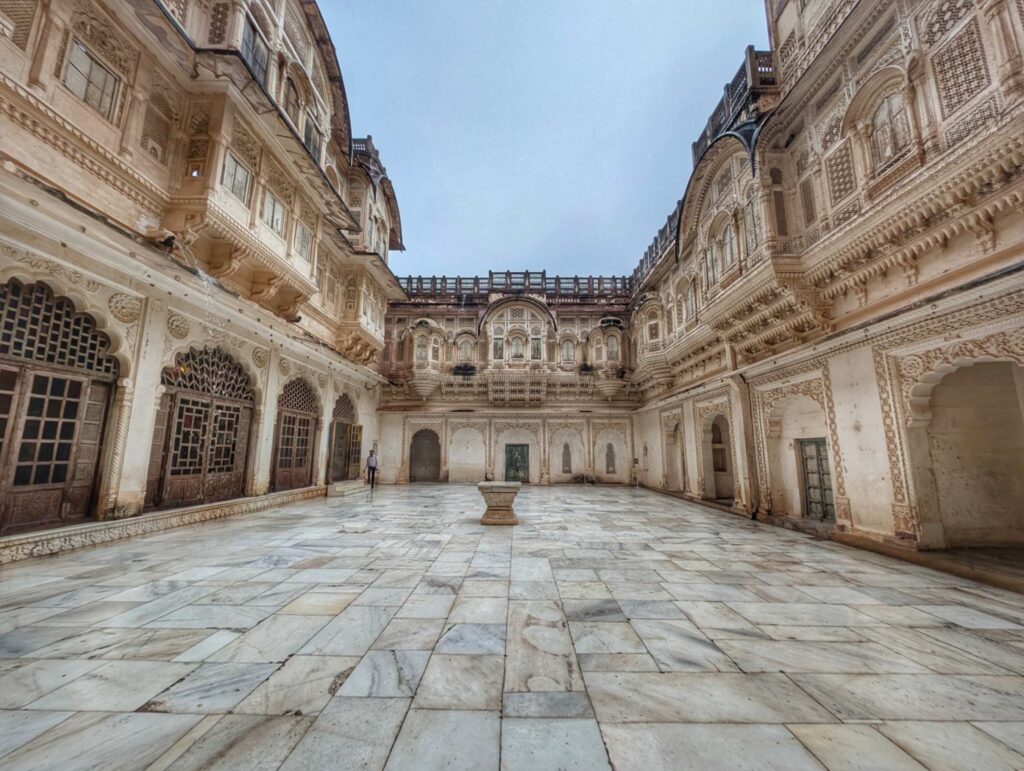
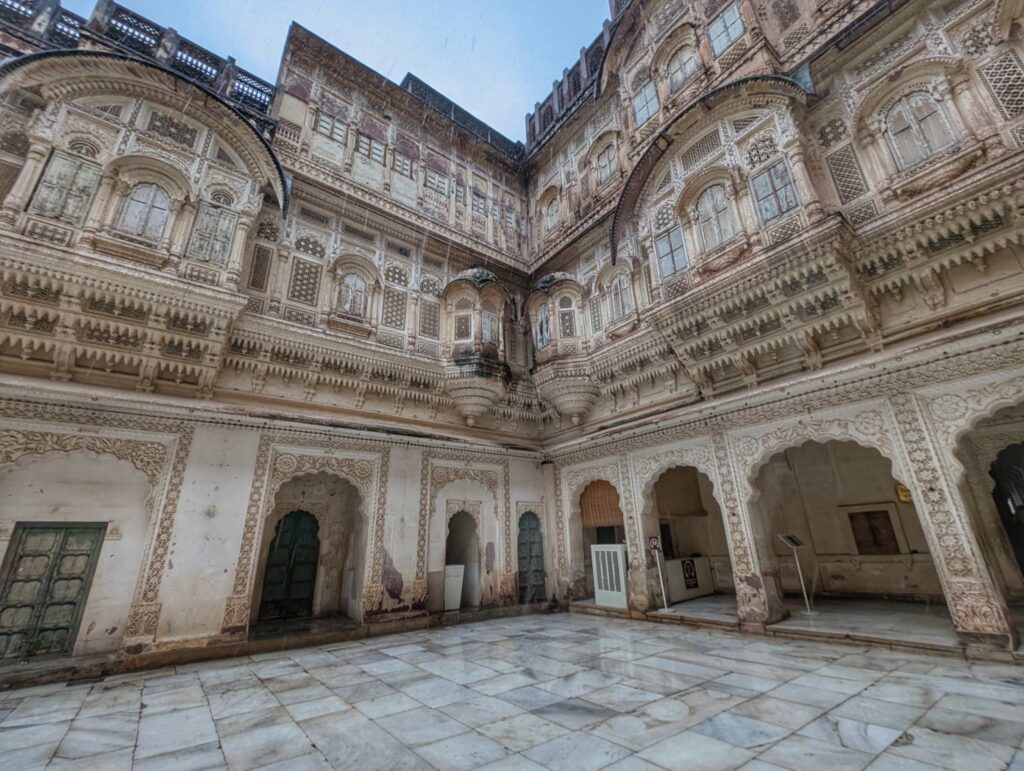
Imagine a rain-drenched Mehrangarh Fort, with the cast dancing and twirling as the clouds gathered. It’s pure cinematic magic that now, walking those same grounds in monsoon, felt like stepping right into that song.
Growing up, this song was my monsoon anthem, and seeing it filmed here, amid the very forts and alleys I now roamed, added a whole new layer of meaning.
The translation, by the way, is delightfully poetic: “The peacock dances in my heart.”
And honestly, during my monsoon trip to Jodhpur, that peacock Mhare Hiwda Mein Naache Mor, indeed ! Because in Jodhpur’s monsoon, the peacock really danced in my heart!
As my Jodhpur monsoon adventure came to an end, I found myself already planning my return trip – yes, during monsoon season again!
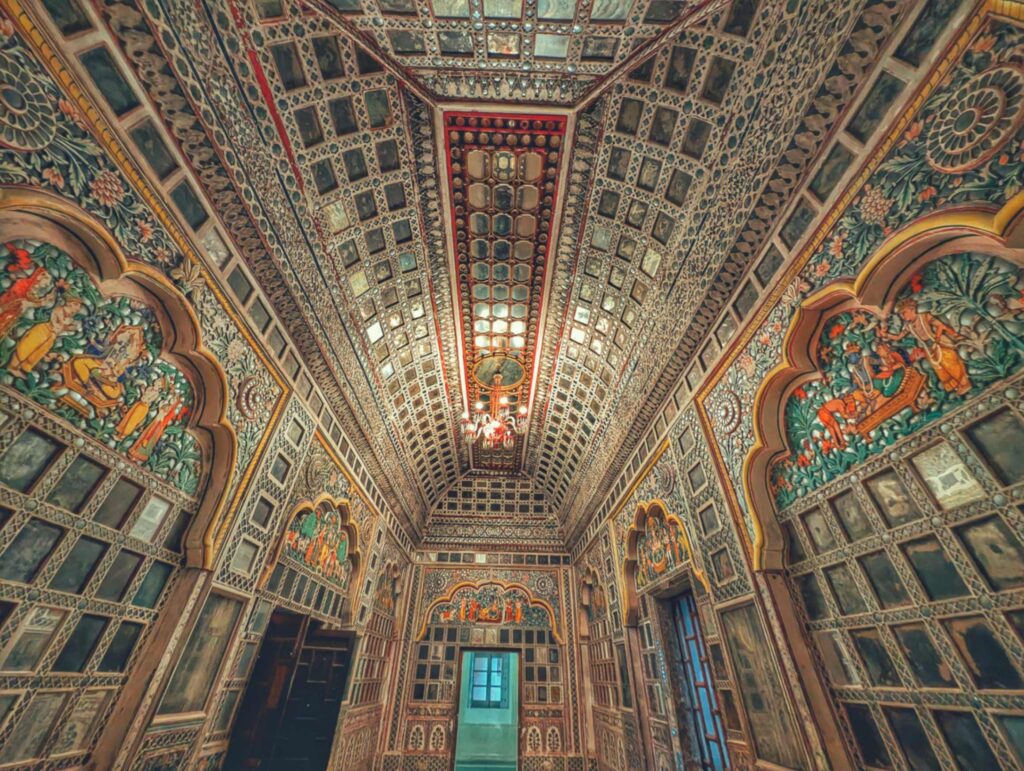
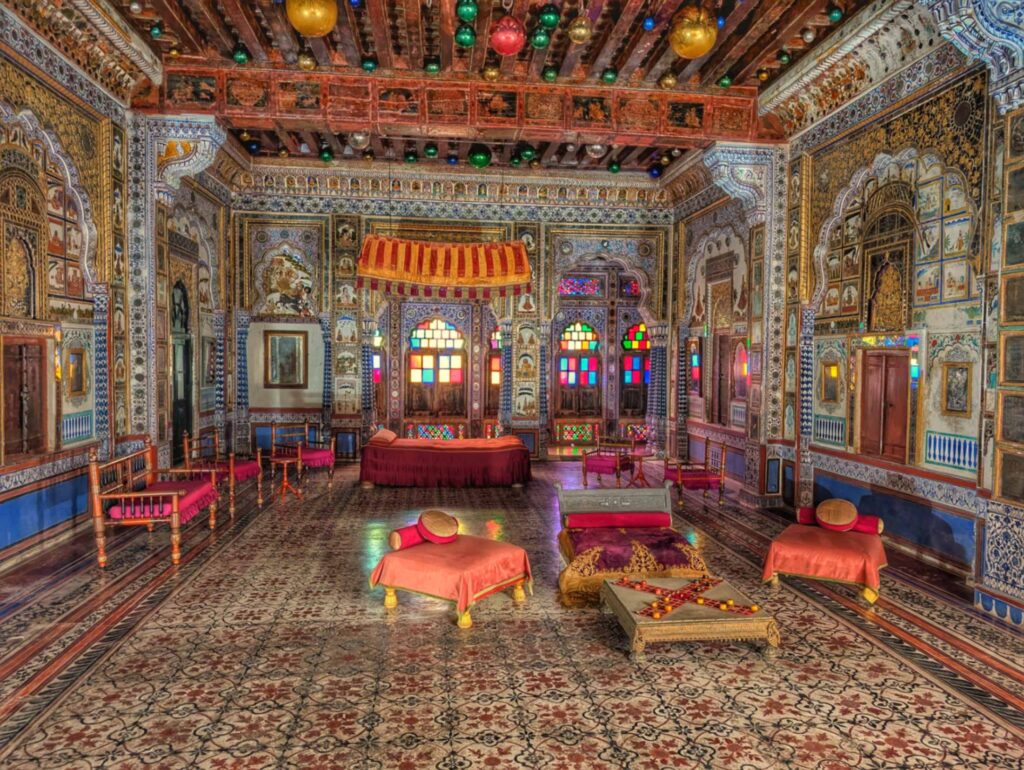
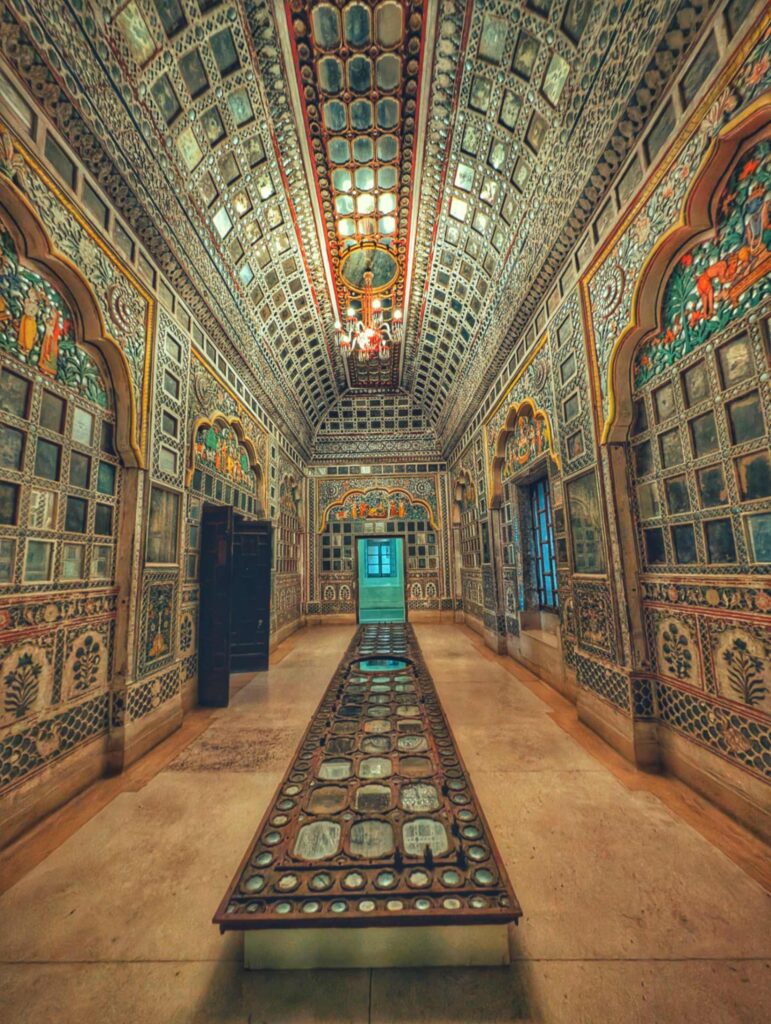
There’s something addictive about experiencing a place during its “off-season” and discovering that it might actually be the best time to visit.
The curse legend of Mehrangarh taught me about sacrifice and devotion, the sati handprints reminded me of the complex history we must acknowledge, and the incredible food scene proved that sometimes the best discoveries happen when you’re not following the conventional tourist path.
Staying at Kankaria Heritage with its excellent ventilation and central location made the entire experience comfortable and convenient. Being able to walk everywhere meant I could explore at my own pace, duck into shops when it rained, and truly immerse myself in the rhythm of the Blue City.
The monsoon in Jodhpur may not be the most popular choice, but for those brave enough to venture into India’s desert state during the rainy season, it offers rewards that go far beyond what any guidebook can describe.
IMonsoon trip here is all about dancing in the drizzle, eating incredible food, walking through history, and discovering that sometimes the road less traveled (or in this case, the season less chosen) leads to the most memorable adventures.
So the next time someone tells you that monsoon is the wrong time to visit Rajasthan, just smile and book your tickets anyway. Trust me, the Blue City is waiting to show you secrets that only the rain can reveal.
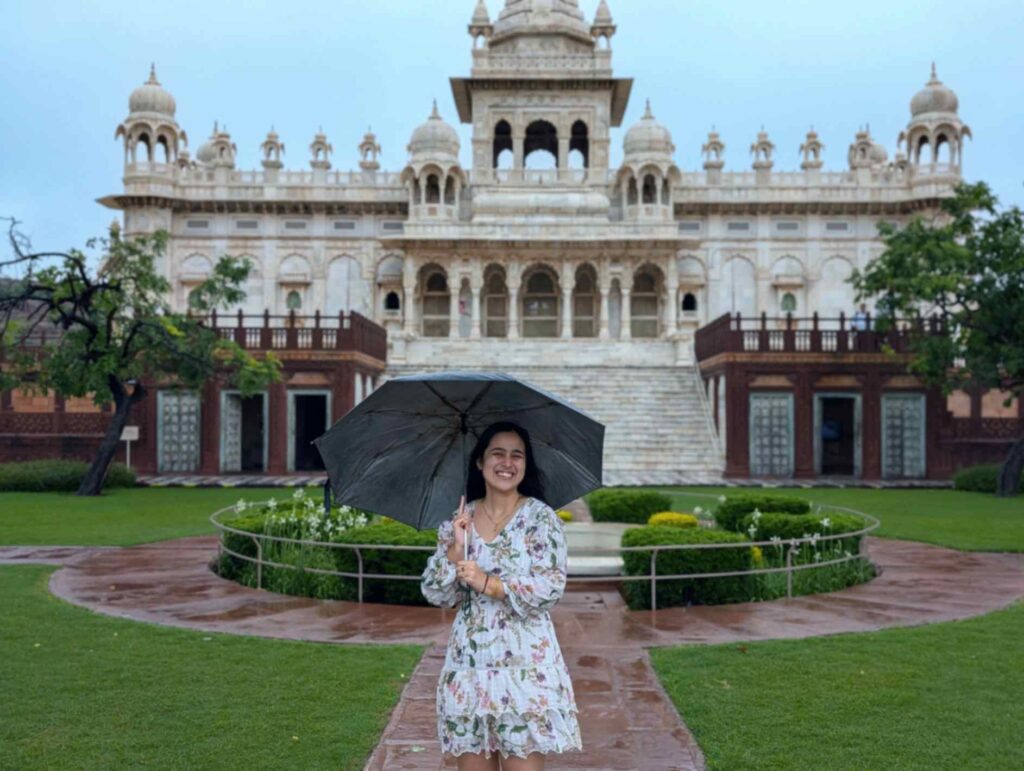
P.S. – Don’t forget to carry an umbrella.
This monsoon adventure in Jodhpur taught me that the best travel stories often come from the journeys everyone advises against. Sometimes being a little crazy is exactly what leads to the most unforgettable experiences.
If you have liked the idea of “Offbeat Rajasthan” , then checkout my other blogs on the under-rated Rajasthani Town of Bundi.
From Forts to Frescoes: A Traveller’s Guide to Bundi, Rajasthan
FAQs
What hostels are available in Jodhpur for solo travelers?
For solo travelers looking to meet fellow adventurers, Jodhpur offers some great hostels:
-Hosteller Jodhpur
-Zostel Jodhpur
-Moustache Jodhpur
-Madpackers Jodhpur
These hostels not only provide budget-friendly stays but also social vibes perfect for backpackers.
When is the best time to visit Jodhpur?
While winter (October to March) is the peak season due to pleasant weather, the monsoon season (July to September) offers a refreshing, less crowded experience with cooler temperatures and lush surroundings.
What are some must-try foods in Jodhpur?
Don’t miss iconic local eats like Janta Sweets’ kachori, Shahi samosa near Clock Tower, Shri Mishrilal’s creamy lassi, the spicy Lal Maas at Gopal Rooftop, and the traditional Dal Bati Churma at Bhawani Dal Bati Churma
Is Jodhpur monsoon travel suitable for families?
Definitely! The cooler temperatures during monsoon and the lush greenery make outdoor sightseeing more pleasant.
What precautions should I take while visiting Jodhpur during monsoon?
Carry an umbrella or raincoat, wear comfortable walking shoes with good grip for slippery streets, and keep your electronics protected from moisture. Also, be mindful of occasional flooding on narrow alleys.
Which neighborhoods are safest for solo stays in Jodhpur
The safest neighborhoods for solo stays in Jodhpur, especially for solo travelers and solo female travelers, are generally around the Clock Tower (Ghanta Ghar) area and Sardar Market.
These neighborhoods are vibrant, bustling, and well-frequented by tourists, making them lively and secure environments with easy access to local markets, food, and key attractions.
Other safe and comfortable areas for solo travelers include:Stepwell Square area near Toorji ka Jhalra, where charming cafes and hostels like Zostel and Stepwell House offer social atmospheres and good security.
Inside the Old City near Mehrangarh Fort, including heritage homestays such as Pal Haveli, which combine traditional ambiance with modern safety.
Well-reviewed hostels like Moustache Jodhpur and Madpackers are also popular among solo travelers for their secure facilities and lively social scene.
Travelers emphasize that while Jodhpur is generally safe, it’s wise to avoid isolated spots at night, use trusted transport, and stay vigilantstandard solo travel precautions anywhere.
The central, tourist-friendly neighborhoods around the Clock Tower and markets strike the perfect balance of safety, convenience, and immersive local experience.
How to reach Jodhpur by Public Transport ?
By Air:
Jodhpur Airport (JDH) has regular flights connecting it to major Indian cities like Delhi, Mumbai, Jaipur, and Ahmedabad. The airport is about 8-10 km from the city center, and taxis or auto-rickshaws can get you there in around 20-30 minutes.
By Train:
Jodhpur Junction is well-connected by rail with major cities such as Delhi, Mumbai, Jaipur, and Udaipur. Trains include overnight expresses and superfast options, making rail travel a popular choice.
By Road:
Jodhpur is accessible via good national and state highways. The Rajasthan State Road Transport Corporation (RSRTC) operates regular bus services from Jaipur, Udaipur, and Ajmer.
You can also hire taxis or self-drive from nearby cities for a scenic route.
Once in Jodhpur, local transportation includes auto-rickshaws, cycle rickshaws, taxis, and walking, especially within the old city and Blue City areas.

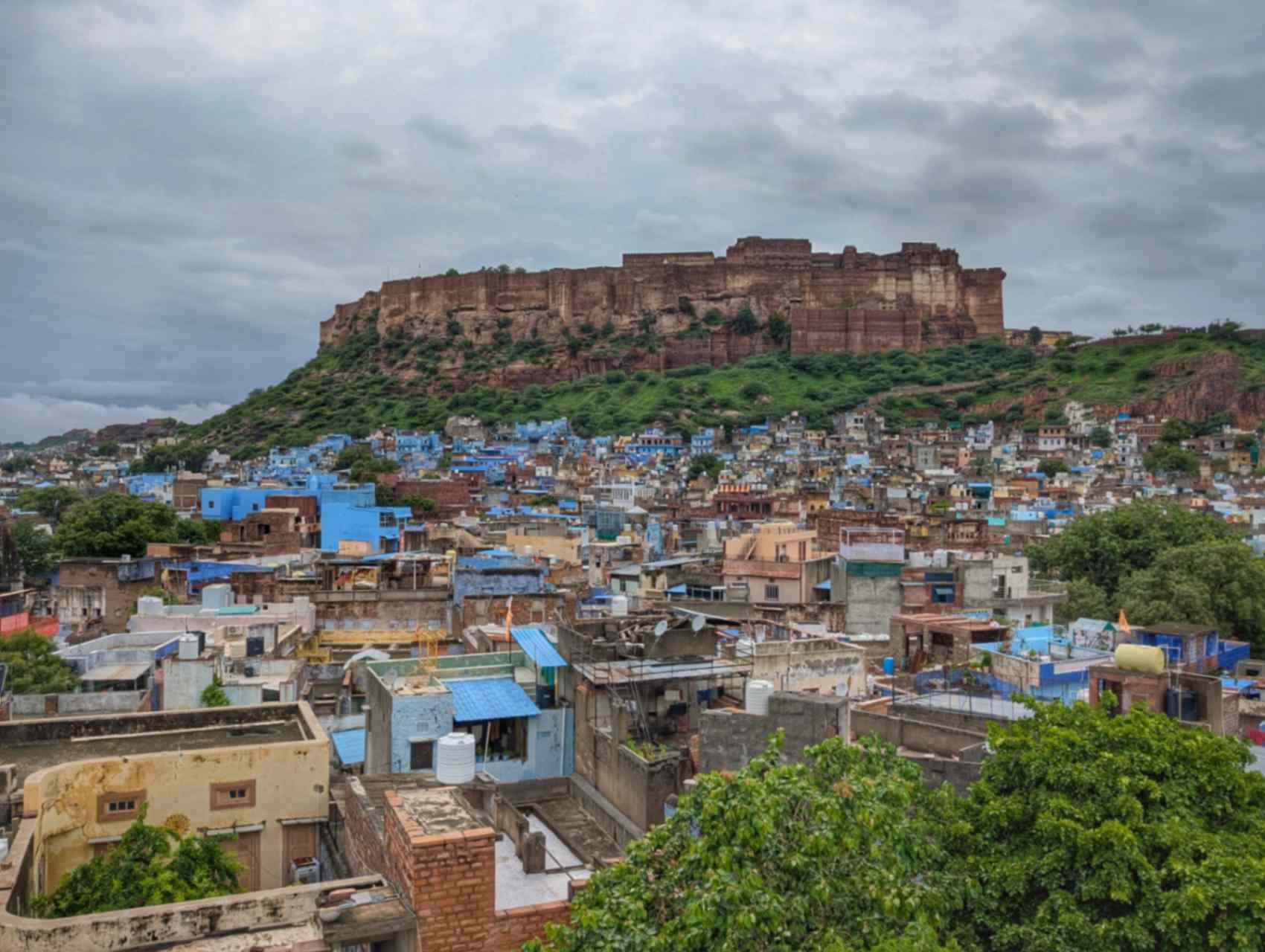
[…] India’s Blue City Jodhpur in Monsoon: A Walking Tour, Legends & Food Adventure. […]